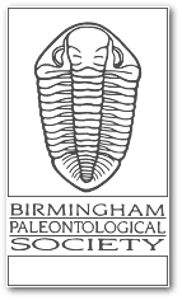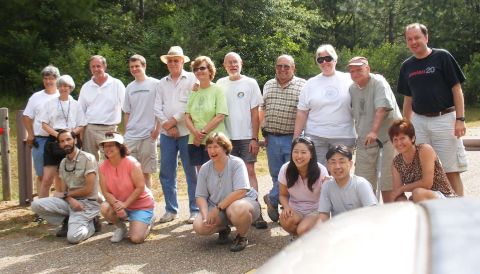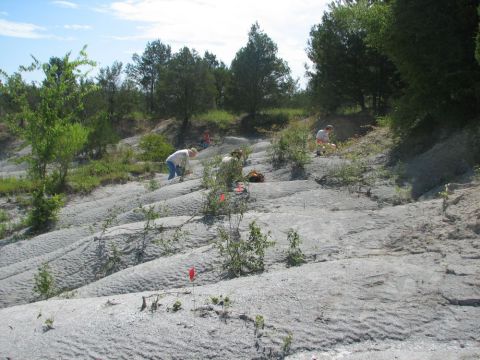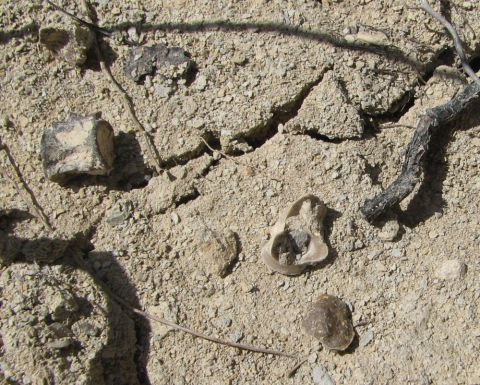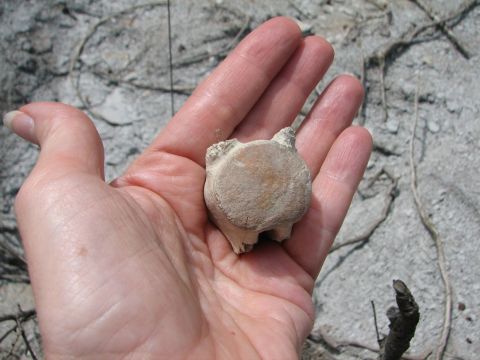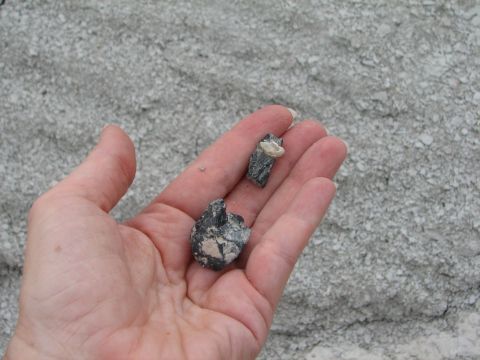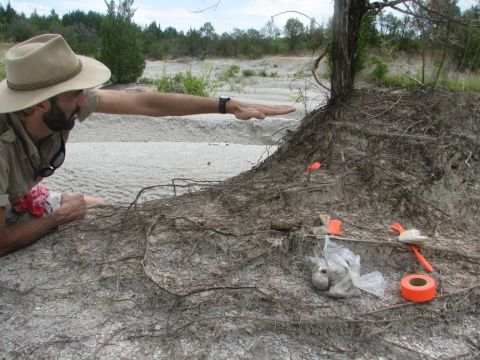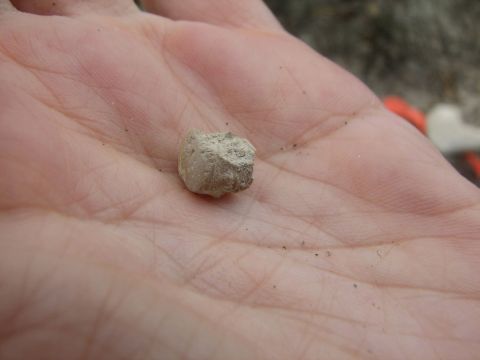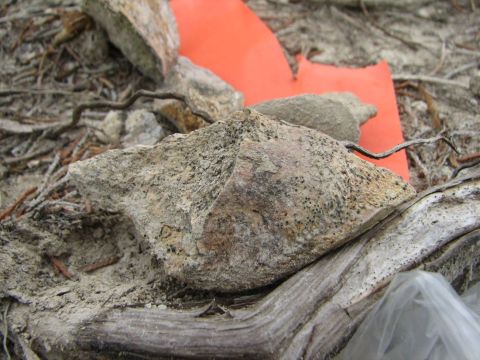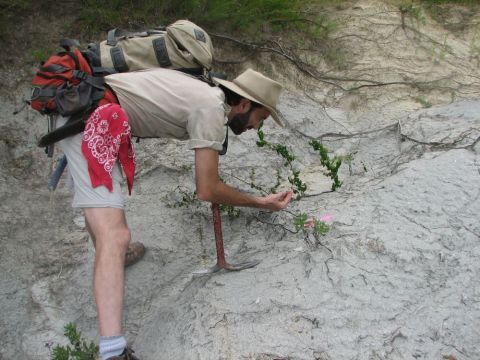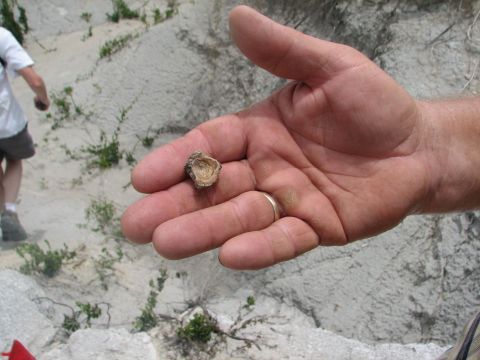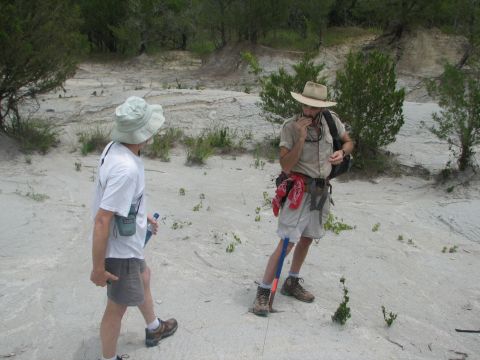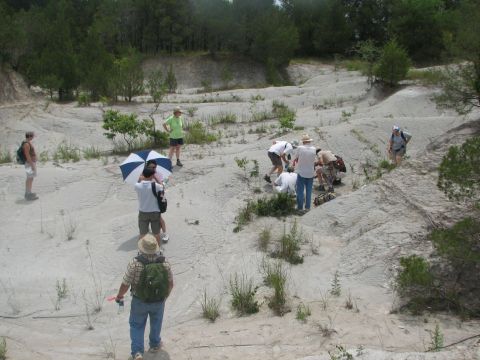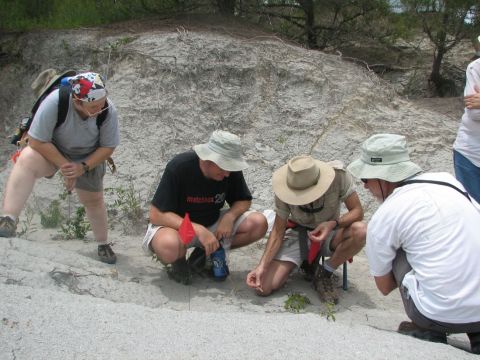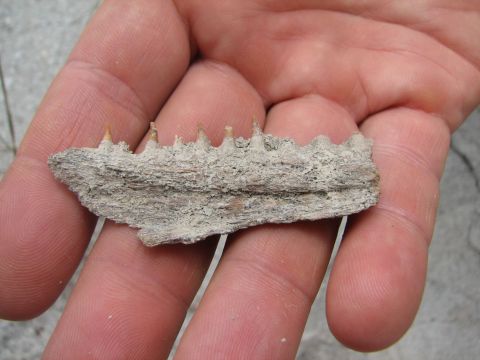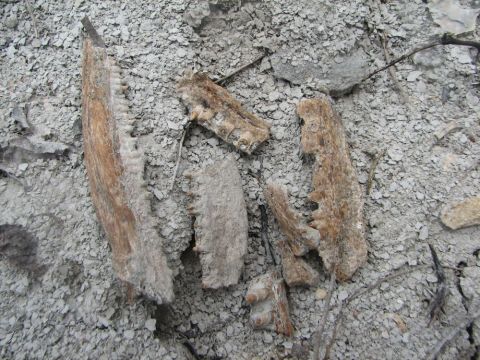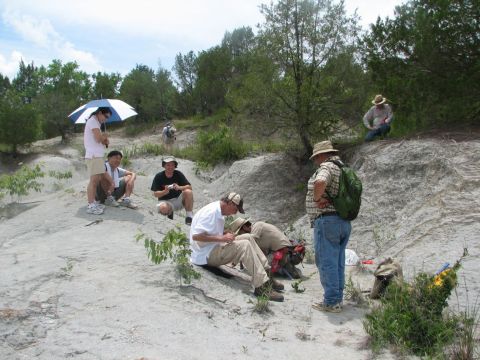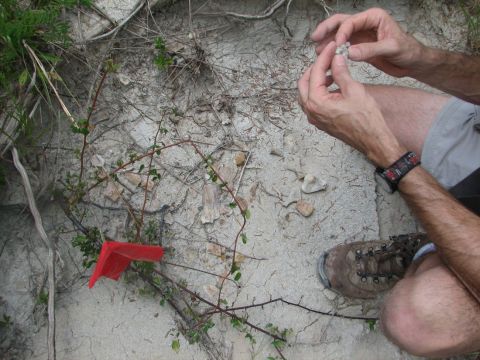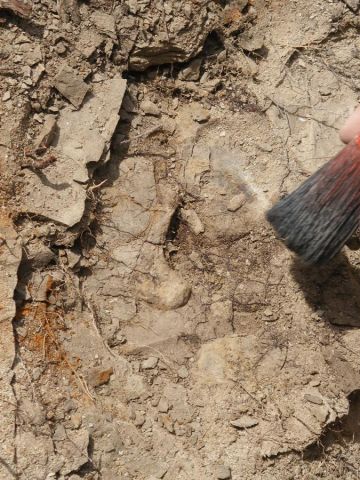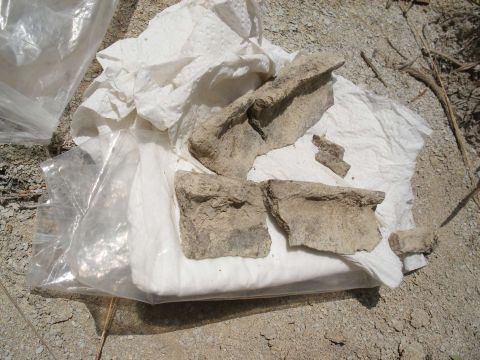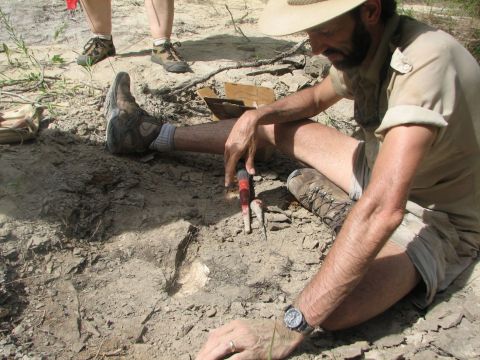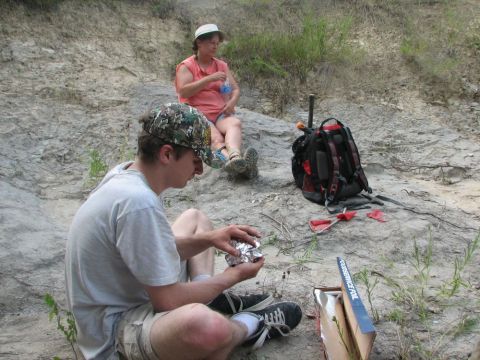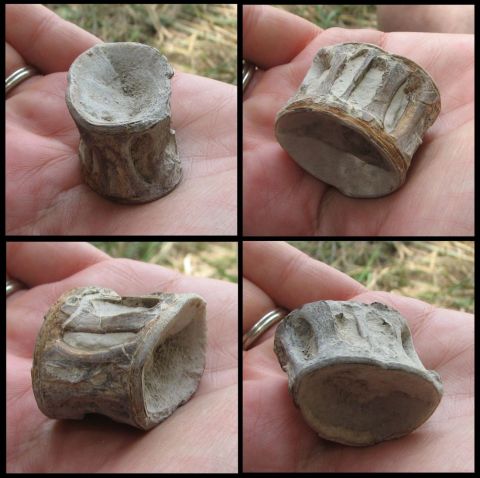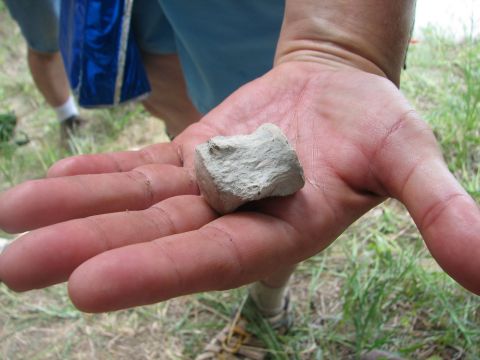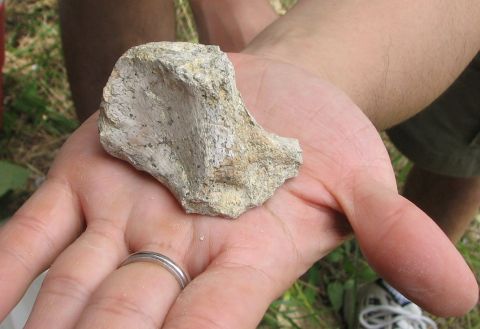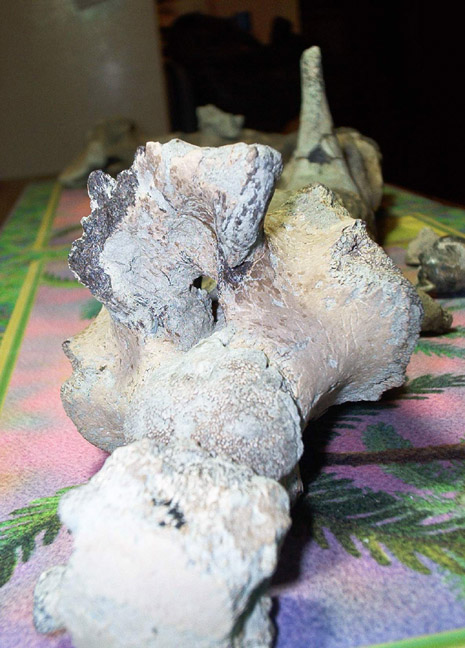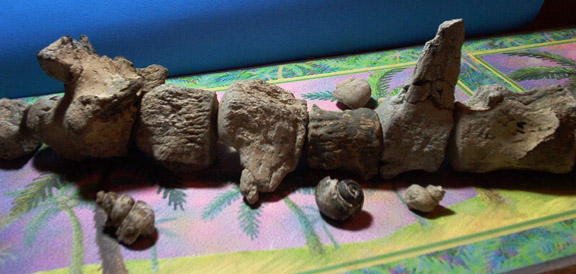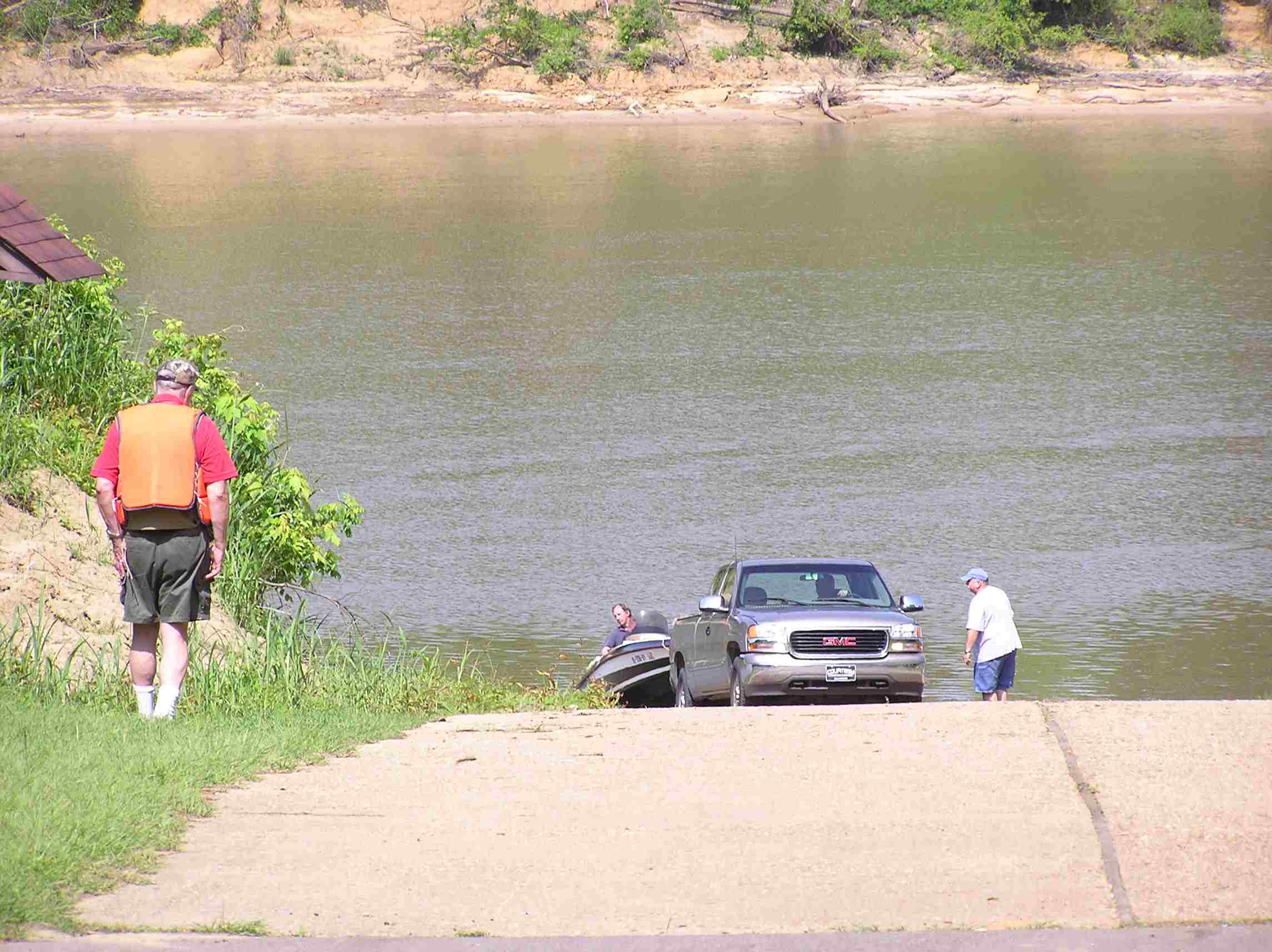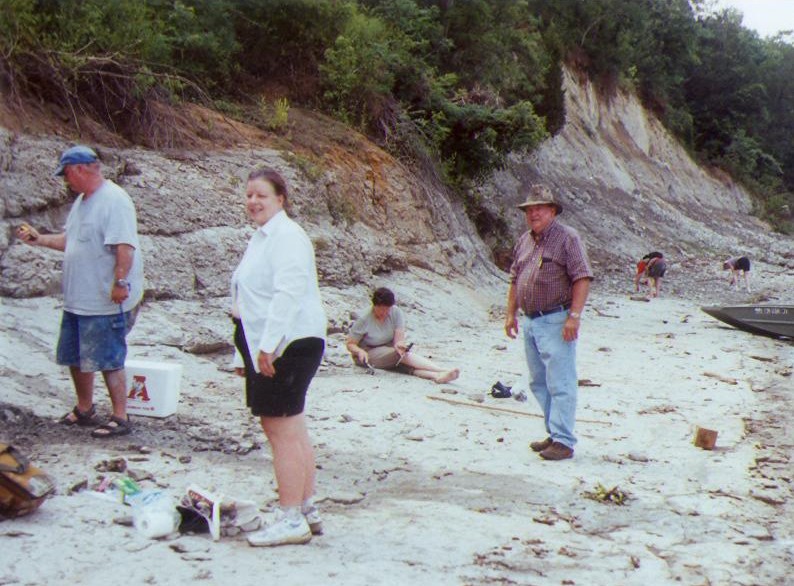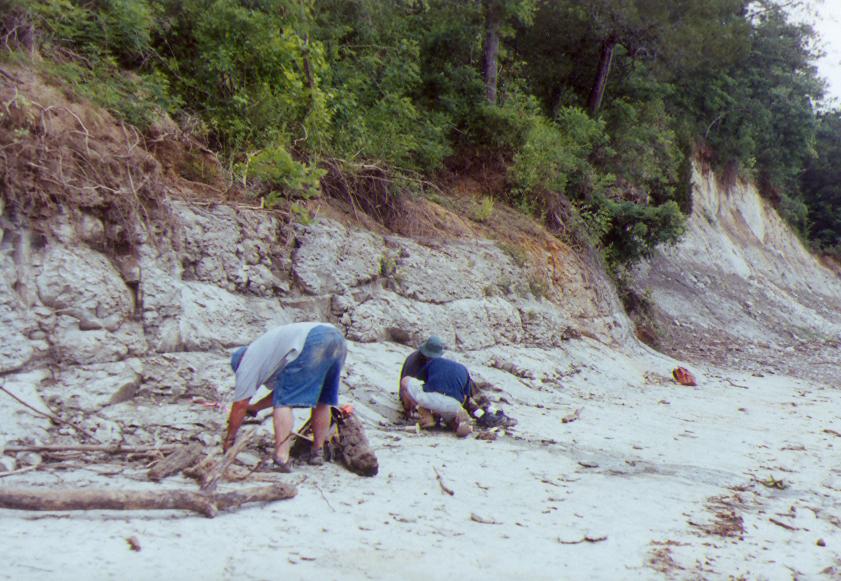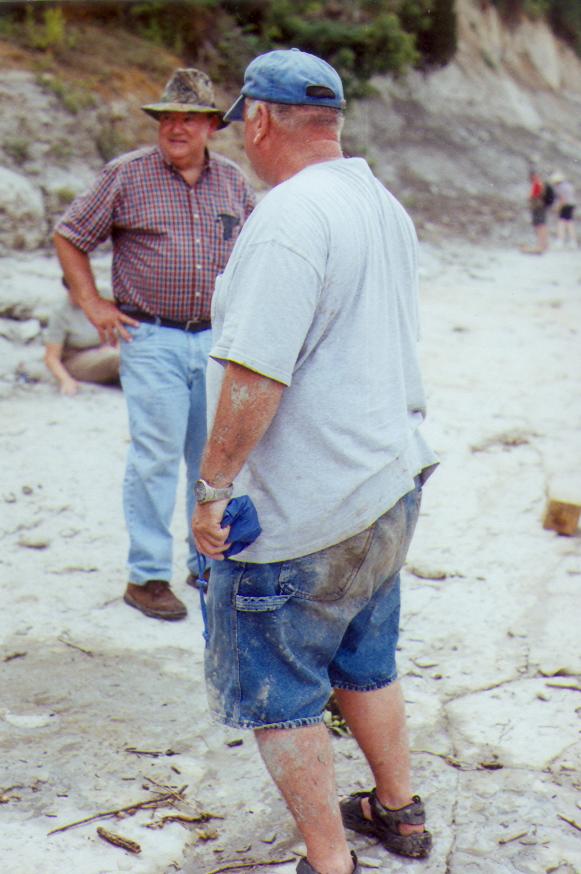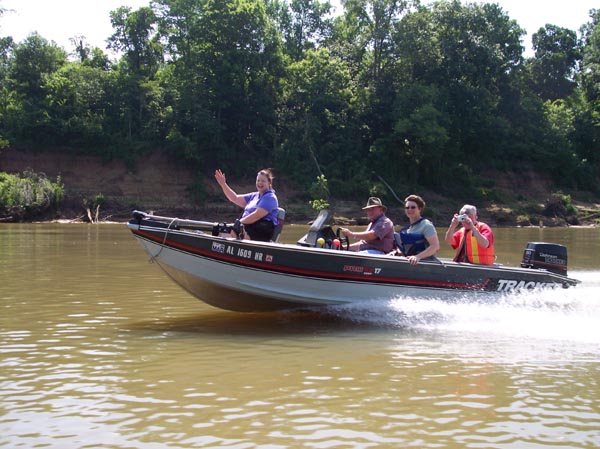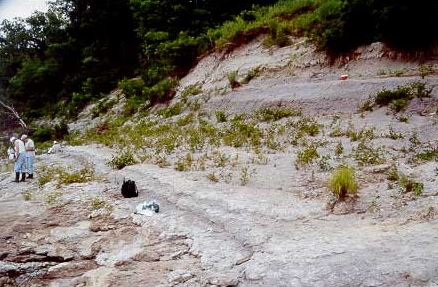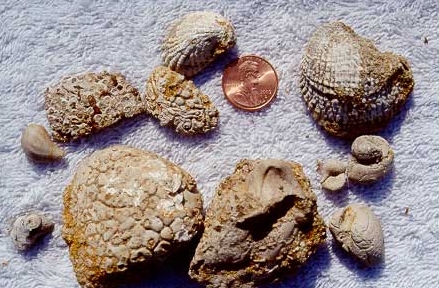The whole gang.
Visitor
Sumter
June 28, 2008 - Cretaceous Fossils, Sumter County, AL
Trip to Sumter County, Alabama. . . more to follow, wanted to get pictures up for everyone.
(Pictures courtesy Jan Novak and Vicki Lais)
After a brief overview of the geology of the area, and a review of collecting and flagging procedures by James Lamb, the group headed out into the gullies. Almost immediately, fossil mosasaur vertebra and turtle pieces are found and marked with flags.
This is a very well detailed fossil fish vertebra. Fossil shells and fragments littered much of the gully.
Several members found blackened fossil wood, which looked like charcoal. Note the shell attached to the wood. Samples were gathered, as sometimes the specimens are so well preserved one can determine the species.
James Lamb spotted the bones of an adult mosasaur skull, and several (5-6) vertebra of a baby mosasaur, mostly caught in the roots of the small tree. One was so lightweight, it was caught in a spiderweb! The bulk of the bones washed down the gully long ago.
We had an area designated as the "Cool Off Station" stocked with cold drinks and fans, manned by Greg, where members dropped off their ice chests and retreated when they got too hot. If you look carefully, you can see coolers hung in the trees, in an attempt to keep out the fire ants. Thanks to Don, who brought popsicles for everyone to enjoy! There was a great view of the gullies from this vantage point.
At lunchtime, James Lamb made the rounds of flags where members had marked fossil finds, with many of us tagging along to learn the proper scientific names (or at least hear them said out loud!), and see if what we found was actually fossil material!
As we hear screams of excitement from Claire, everyone begins converging on the site where Jan found a nicely preserved fish jaw with teeth, and also vertebra and other bones.
A fossil oyster shell bed is in the background, with an enchodus tooth in the lower right, a fish vertebra, shell and what appears to be a coprolite specimen in upper left.
Parts of a turtle bone during excavation, using a soft brush to keep the dirt cleared away.
Standing around cooling off as the turtle is being excavated, and showing off finds from various parts of the gully.
Pectin and other shells were found in the chalk layers as the turtle was being excavated.
As James Lamb excavates dirt, more and more turtle bone is exposed, Also a large shell is in the same area.
John carefully wraps foil around the turtle bones that have been excavated from the site by himself, Larry, and James Lamb.
- ‹ previous
- 98 of 99
- next ›
November 2, 2005 - Cretaceous Fossils, Sumter Co, AL
BPS members went down to the Tombigbee in search of specimens from the marl limestone sequences in the Arcola Limestone Member (Late Cretaceous Campanian 83-74 mya). Steve and Bobby furnished the boats. BPS members climbed aboard and we headed off down the river. This is one of our favorite spots so anticipation was high. Once arrived, we headed off in different directions, some going down to the far end of the beach in hopes of finding a large ammonite like the one found last trip.
The water was very low on this trip, exposing areas we had never collected. Another mosasaur bone, probably from our “pet” Mosasaur, “Bigbee” was unearthed, much to our pleasure. Numerous pieces of carboniferous wood were found, also worm tubes, gastropods and a very nice portion of a turtle, which was jacketed for prep work back home. Several shark teeth, straight cephalopod segments, and some fish teeth were also found.
We had very pleasant weather, and, after a full day of collecting, some wanted to settle in for some food and conversation while another part of the group decided to head down the river to a marcasite collecting area . Some very nice crystalline calcite specimens were found, in addition to the large quantity of marcasite. Much to our delight, it turns out that we had a marcasite specialist amongst us who gave us an impromptu lecture on marcasite characteristics. This inspired discussion of the possibility of forming a coprolite committee. Any volunteers? Anybody want to explain to the general public exactly what coprolite IS? Or was.
As it was getting too dark to see, it was decided that food and conversation seemed like a pretty good idea at this point, so we caught up with the others and finished off the day in great style.
Great trip, great weather, great group, great food.
--Edited by Vicki Lais
(Photos courtesy Anca Croitoru, Lea Novack, and Vicki Lais)
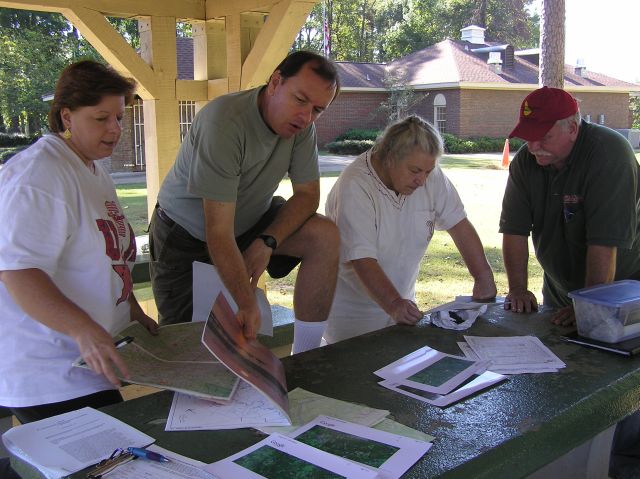
Reconnaissance session covering the geology of the area and sample specimens.
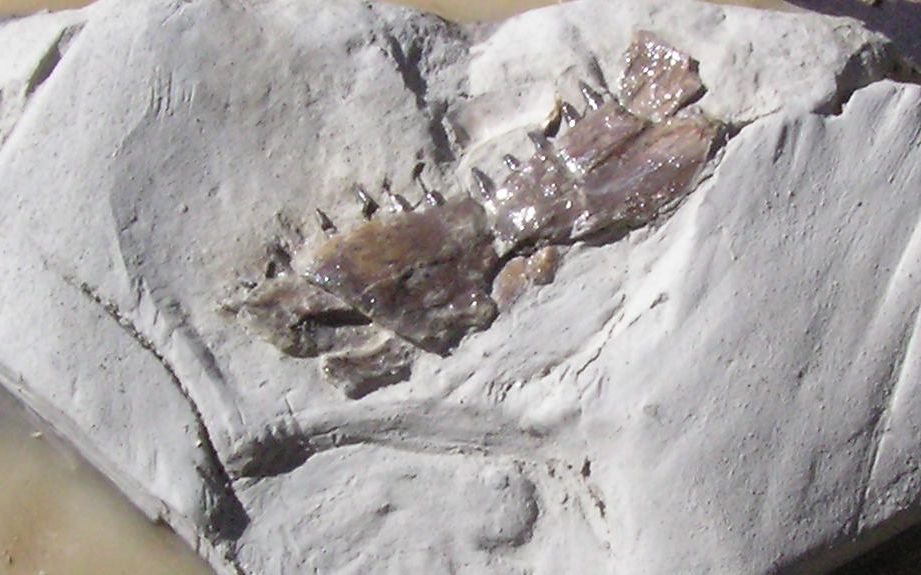
This is an excellent specimen of a fish jaw that Greg found on a previous trip.
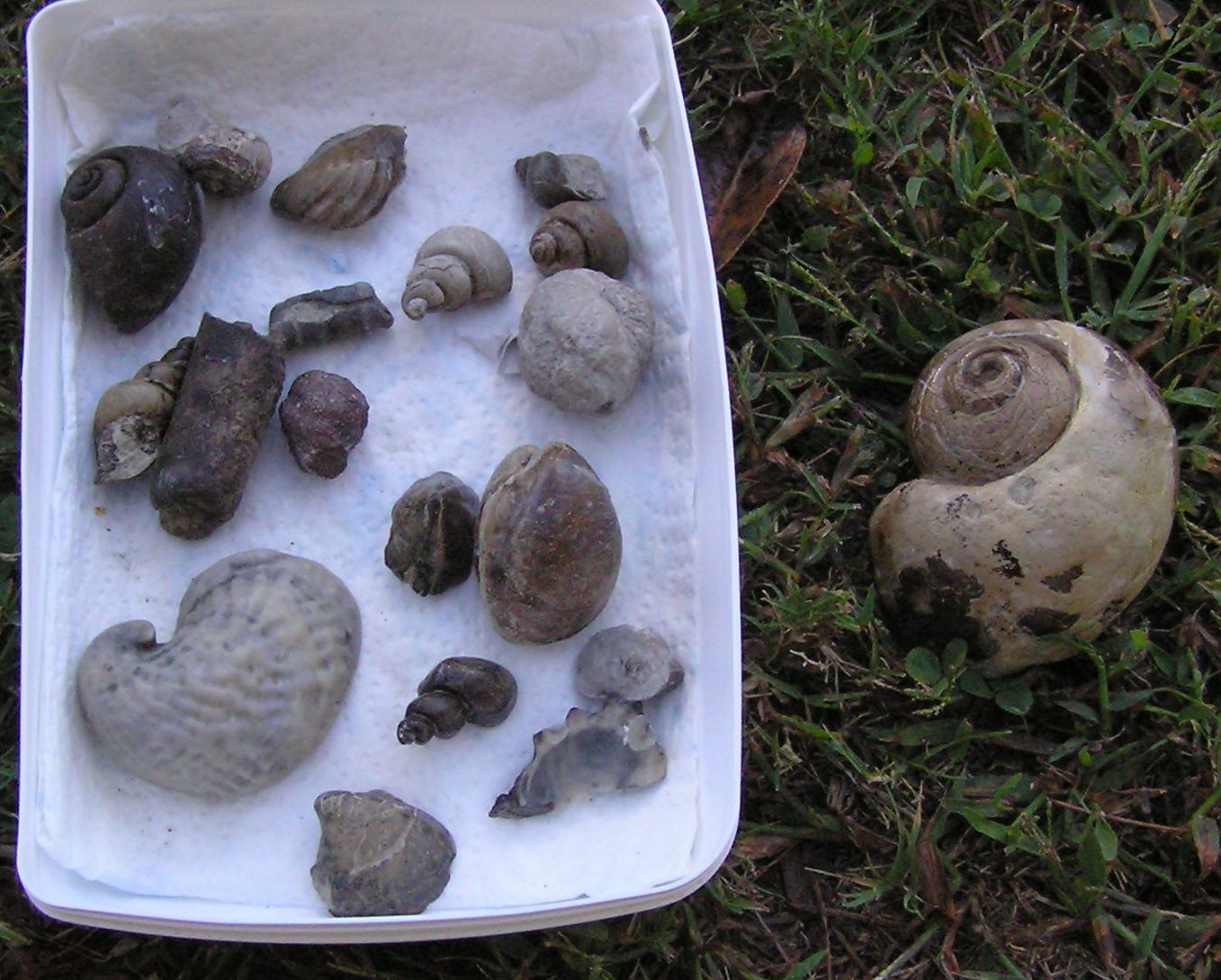
Gastropods and straight cephalopods found on prior trips.
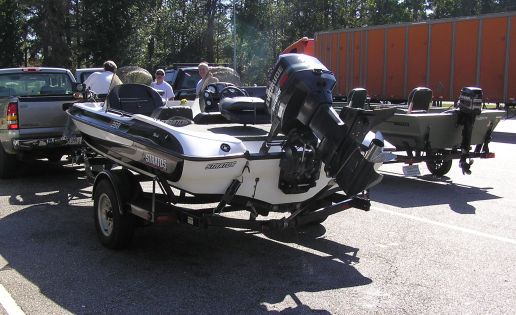
Lining up the boats.
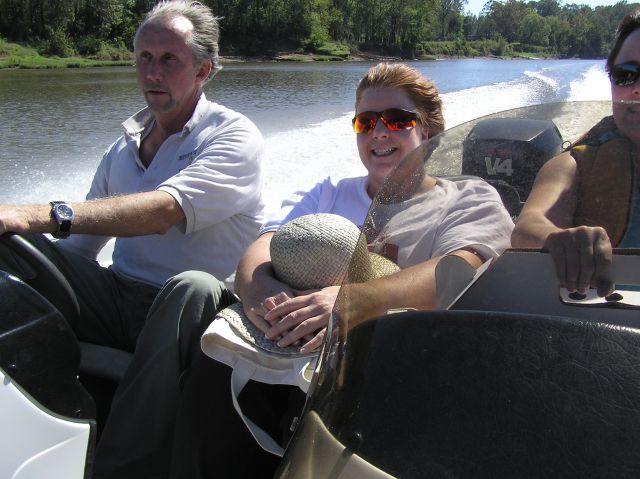
On the way again. . . .
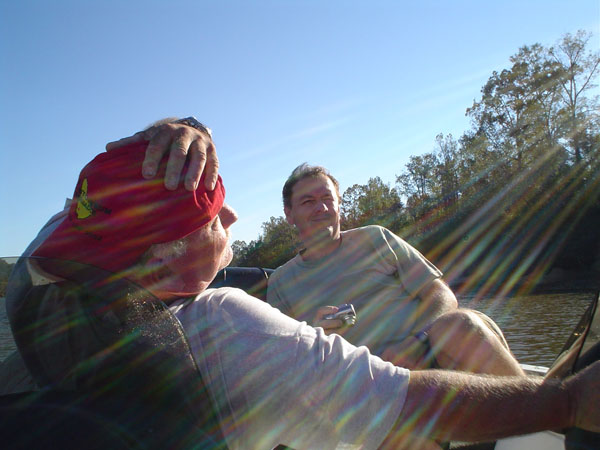
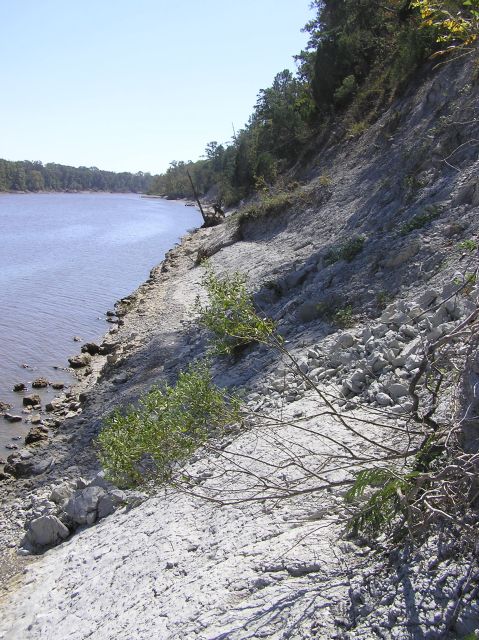
Rocky bluffs composed of Arcola Limestone. Very fossiliferous.
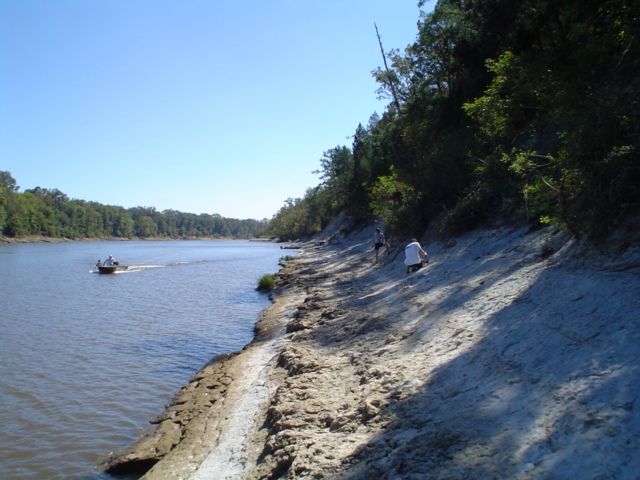
More views of the river.
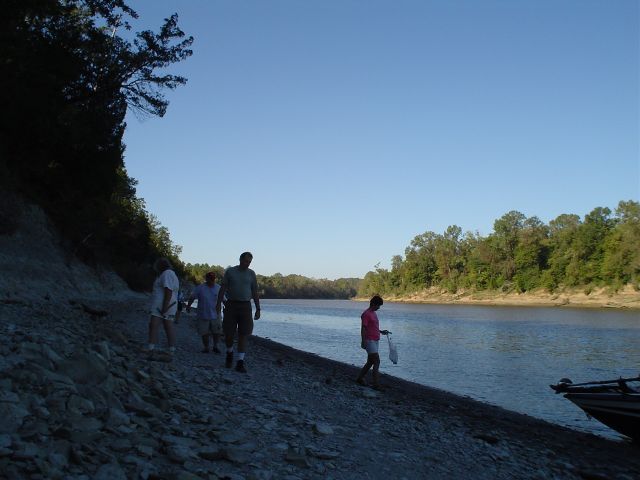
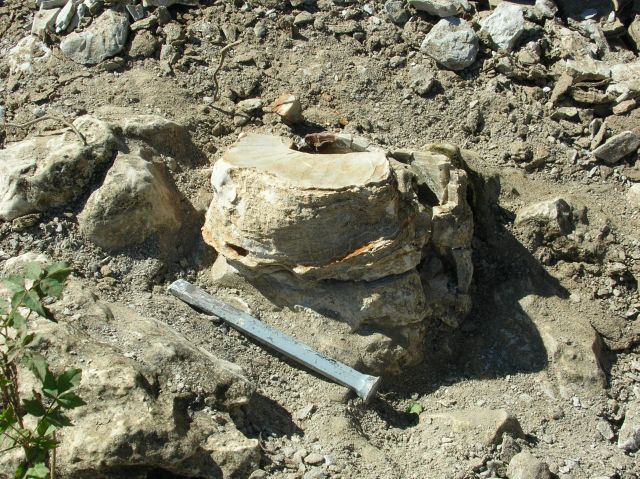
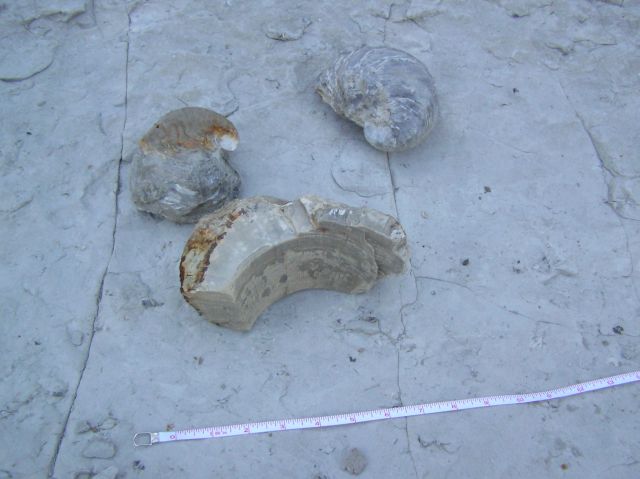
Large piece of shell and exogira.
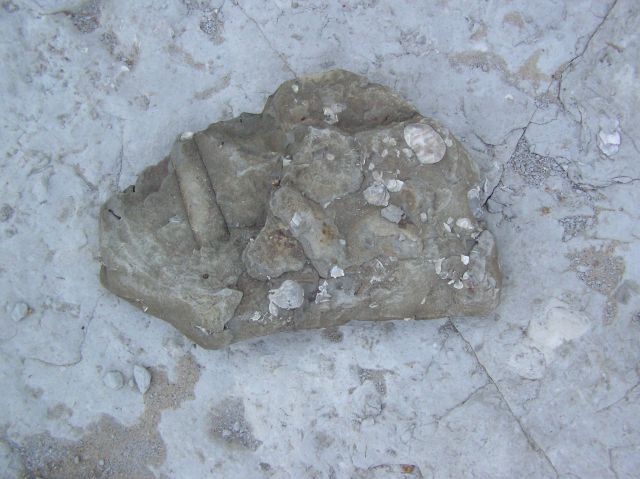
Miscellaneous shells and straight cephalopods.
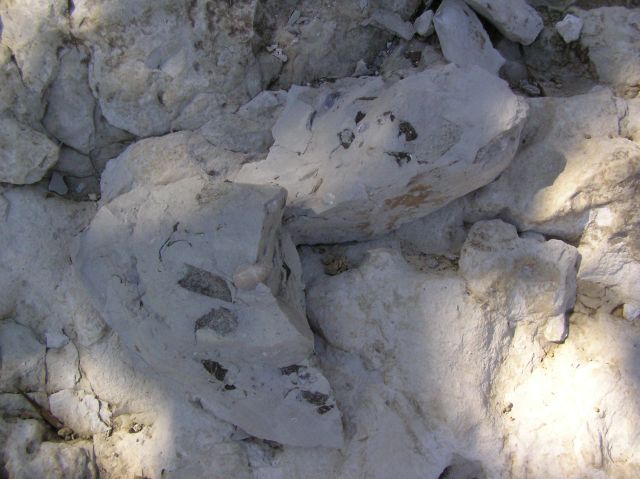
Numerous shell pieces in the limestone.
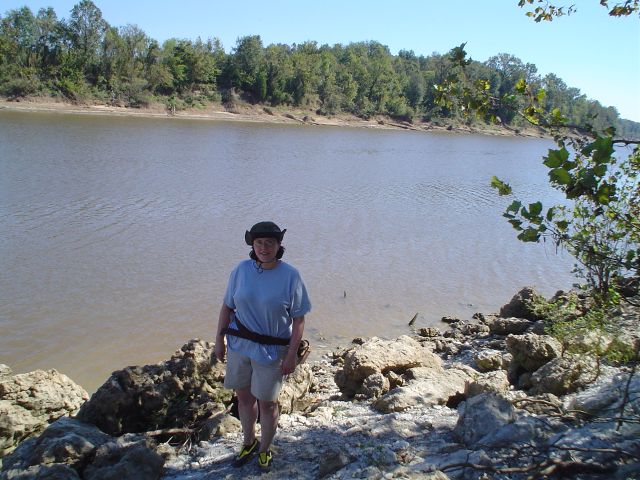
Anca beginning her search.

Loni found a nice turtle specimen, and asked that Greg and Leisa excavate the bones.
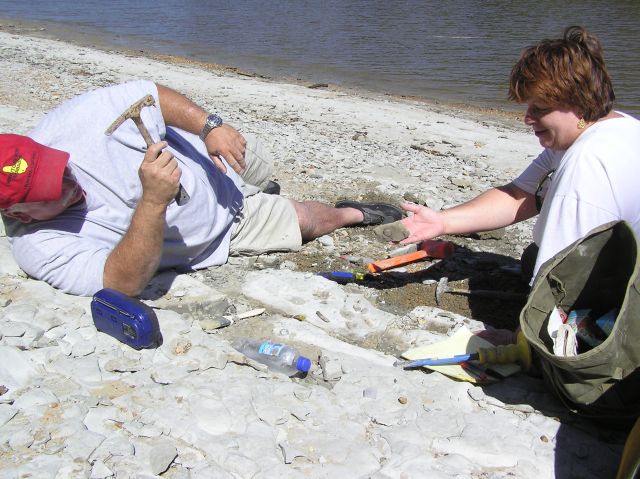
Excavation has begun. . . .
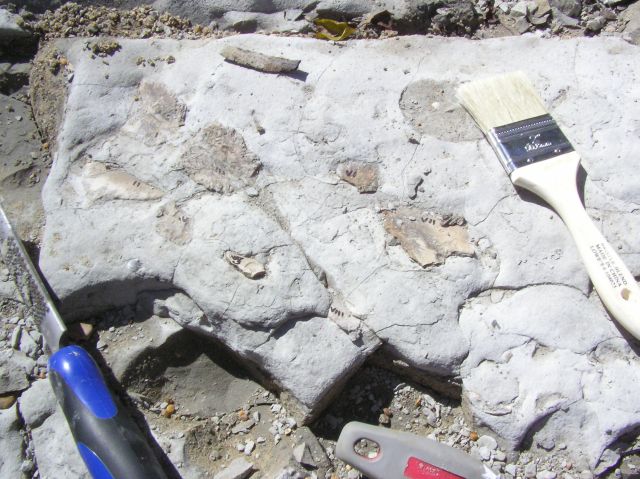
A closer look at the turtle parts.
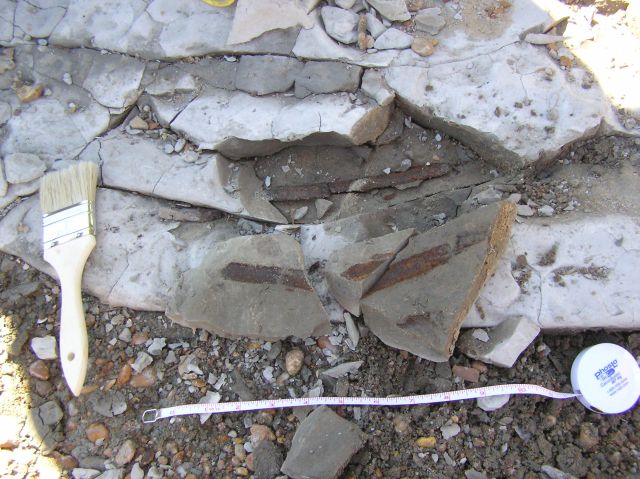
Part of the turtle.
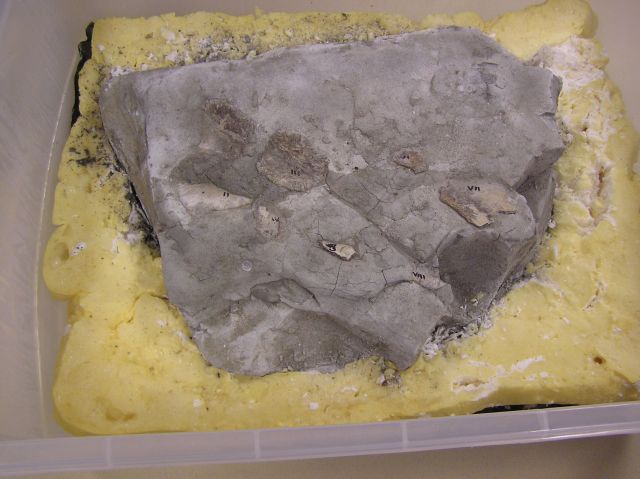
Turtle after preparation. Click image for a different view.
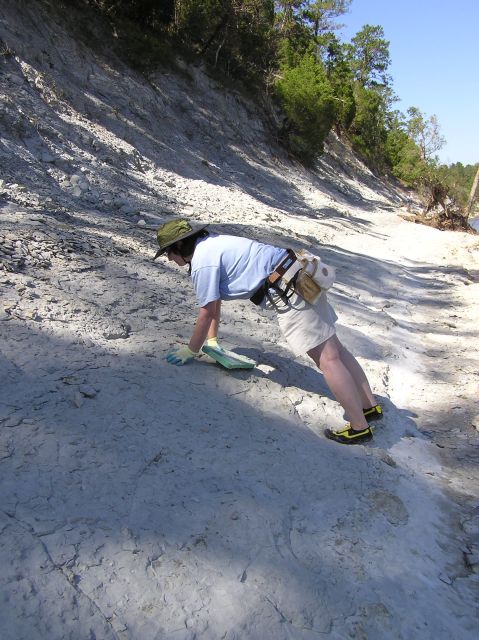
Anca is closely examining the limestone. She found a fish tooth in this area.
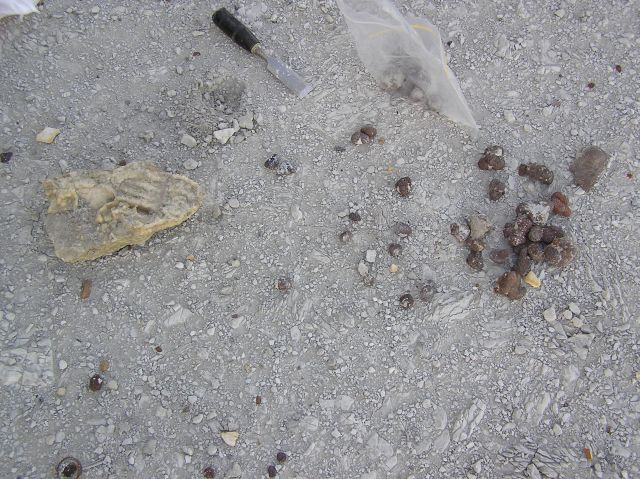
Another site further down the river where we collected marcasite.
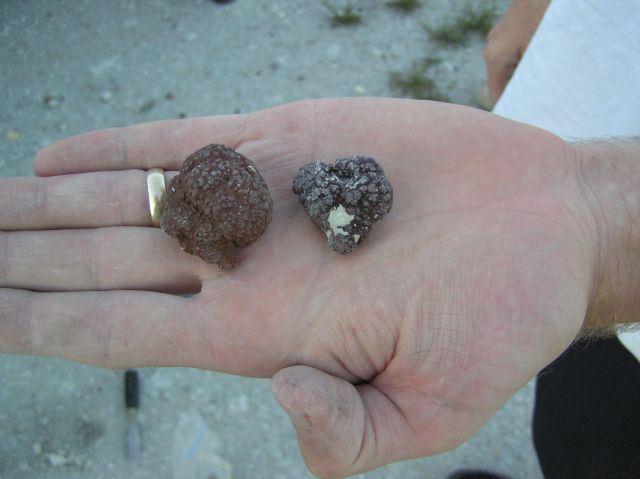
Michael with some nice marcasite specimens. We discovered he is a marcasite specialist, and some of us discussed the need for a Coprolite Committee.
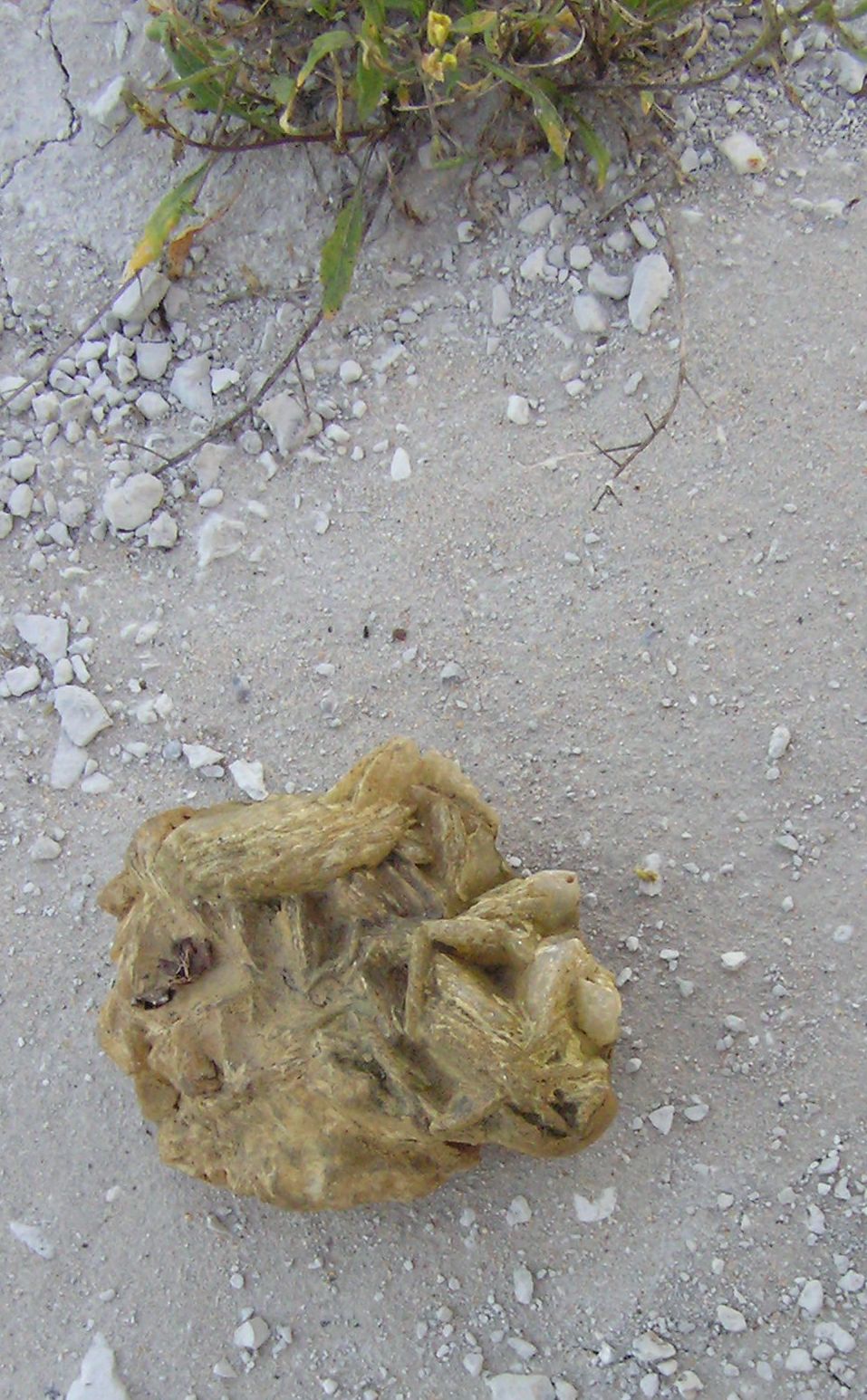
Claire also found a fantastic specimen of calcite, about the size of a fist.

View of the river.
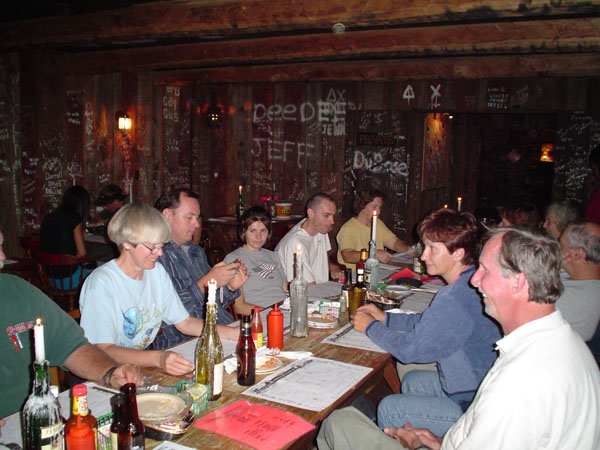
We ended the day with more good conversation at a restaurant near the collecting site. Another "way out in the boonies" place with no advertising; if you don't know where it is, you probably won't even find it by accident.
April 23, 2005 - Cretaceous Fossils, Sumter Co, AL
Steve was spotted tooling around in the boat, looking as if he planned to go way down to a place that was difficult to walk to, so Vicki stuck out her thumb and she and Paige hitched a ride. A very exciting time getting into that boat from a cliff face! Claire decided not to try the boat trick, but decided to risk walking along the steep bluff. We got there about the same time, and of course were looking for "great treasures". Vicki spotted something that looked "odd" pretty quickly, and it turned out to be part of a large ammonite embedded in a huge boulder that everyone had walked past. We all started hunting around that area, but didn't find the other half. Further down, Steve stuck his hammer up under a rock before putting his hand there to check for fossils. Good thing he did, because a cottonmouth attacked the hammer! After moving away from the snake, we heard Claire squeal. She had found another large ammonite near where the first one was found, and it was almost complete. Steve just shook his head, and declared he would never pick up hitch-hikers again!
A small group took off on a scouting expedition after the trip was officially over. They found a nice shelf area with numerous fossils which were very fragile and easily breakable. So, we'll just enjoy the pictures! Found a number of very nice ammonites, a few shells, and pieces of fossil wood.
A big THANK YOU goes to Captain Gilbert and Captain Steve for the use of their boats!
(pictures courtesy Lea Martin, Claire Smith, and Vicki Lais.)
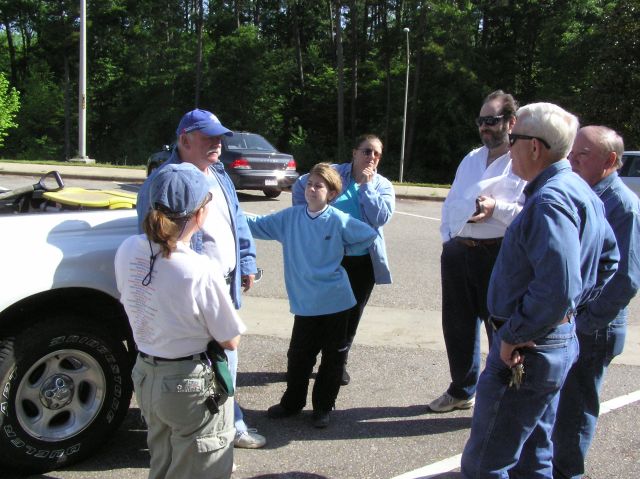
Hanging out waiting for everyone to arrive.
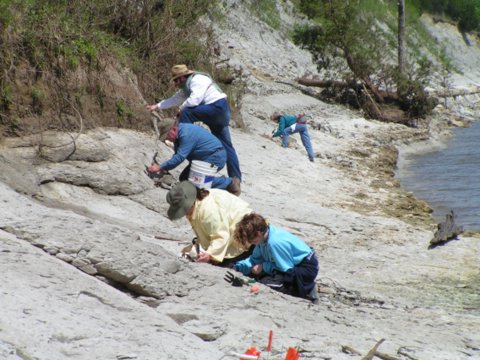
Paige, Leisa, Gilbert, Carl & Vicki popping out the small gastropods and straight cephalopods.
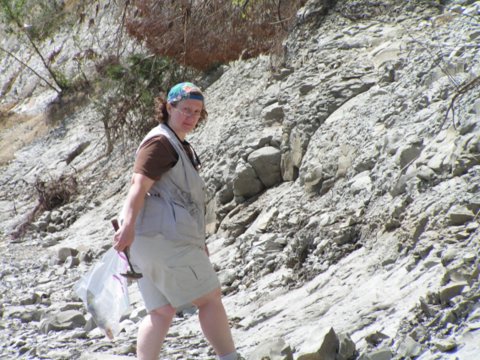
Claire is just getting started.
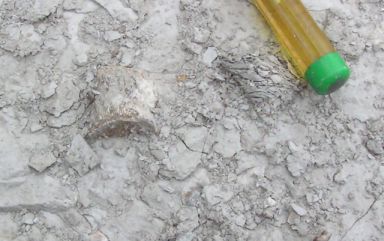
Mosasaur vertebra found by Vicki, quite a distance from the others that were found on the last trip.
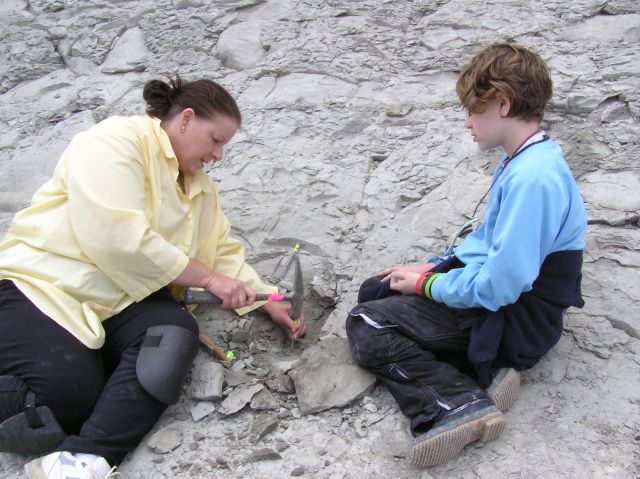
Leisa excavating around a fragile fossil.
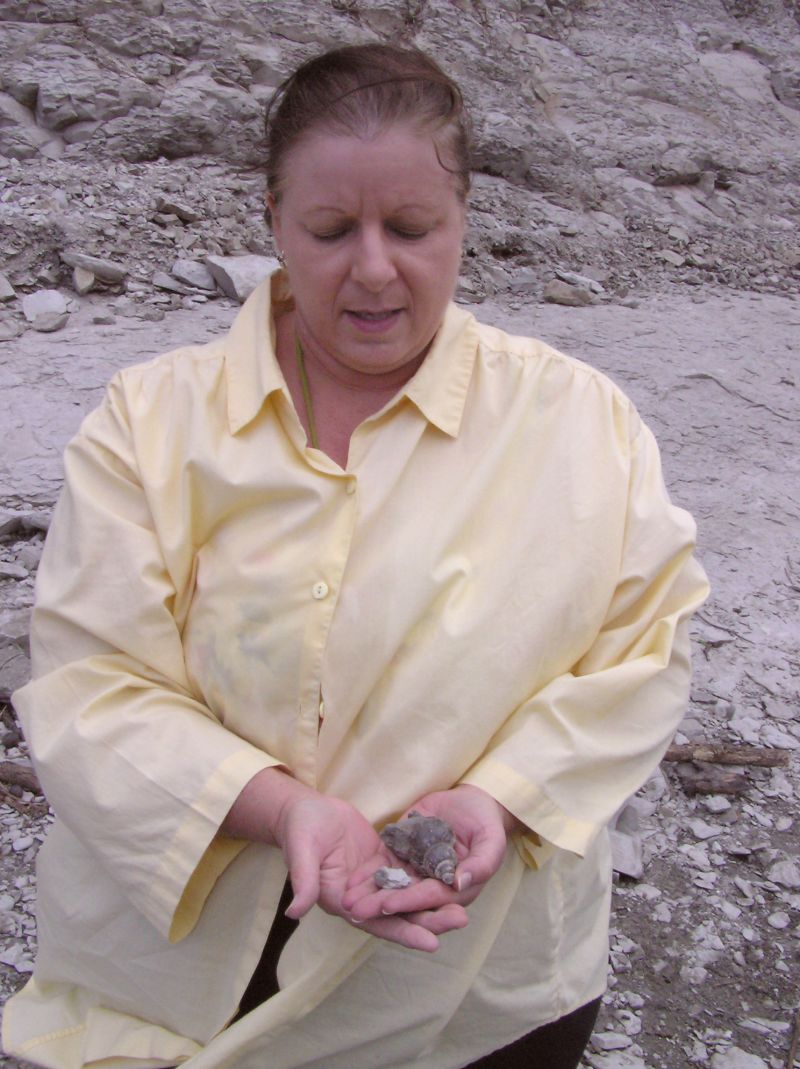
And the nice gastropod she collected.
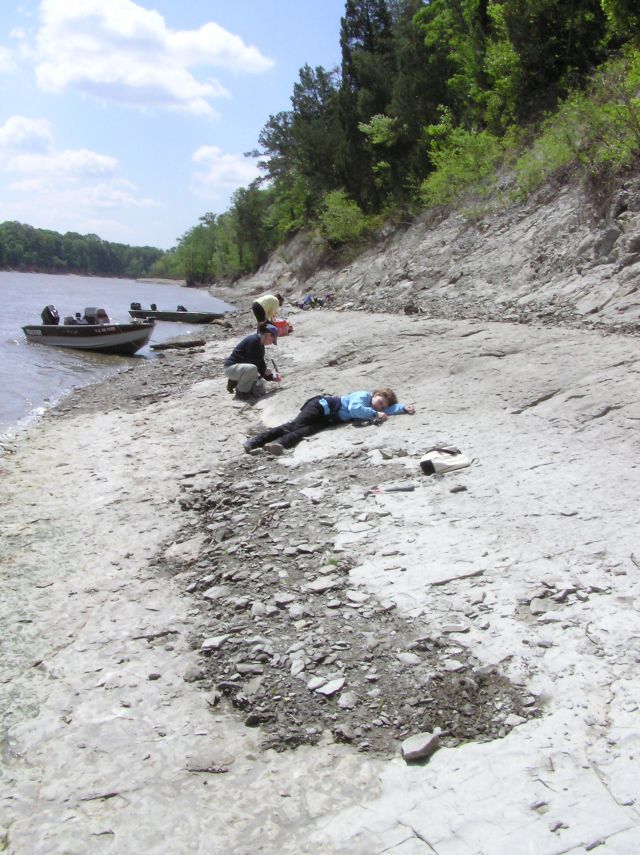
The chalky shoreline. (Paige isn't tired, just getting a closer look!)
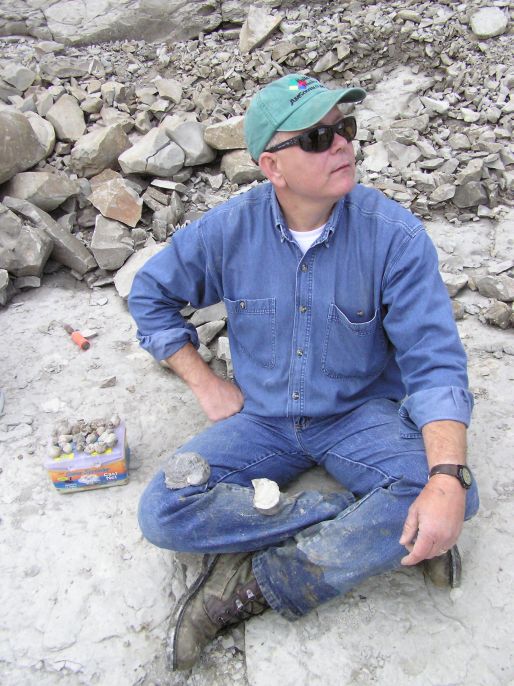
Steve's attention has just been diverted as someone stopped to talk . . .
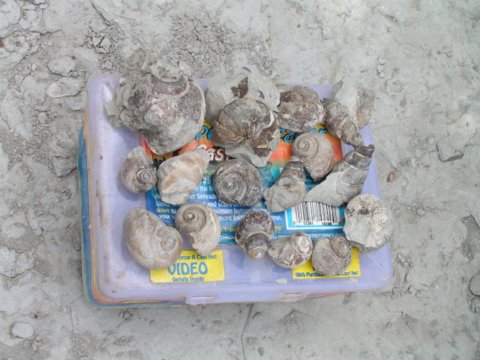
Close-up of some of Steve's finds, mostly gastropods. There is also a nice mosasaur bone in that box.
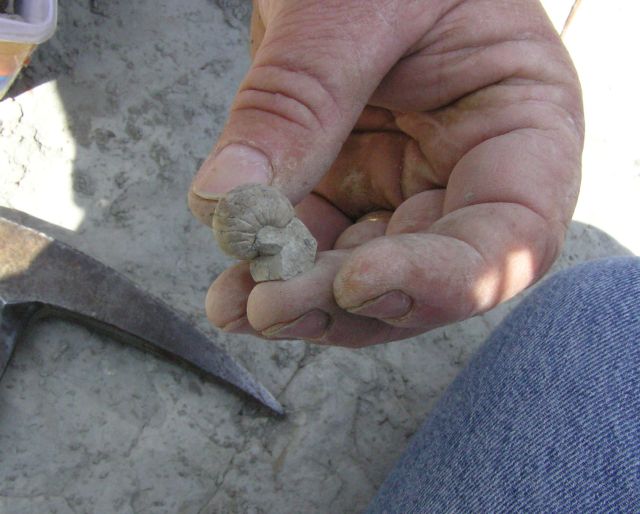
Tiny nautiloid found by Steve.
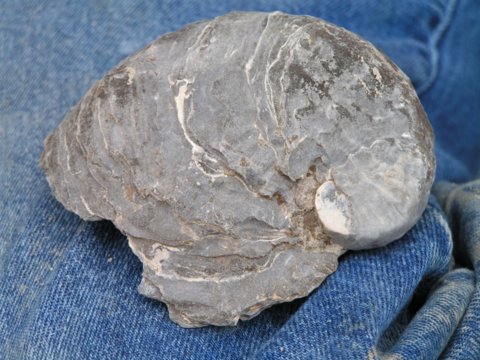
Several Exogira were found.
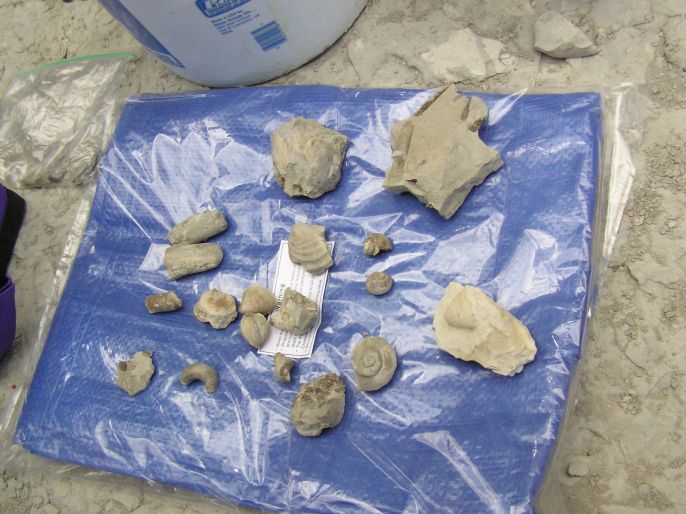
Some of Lea's finds.
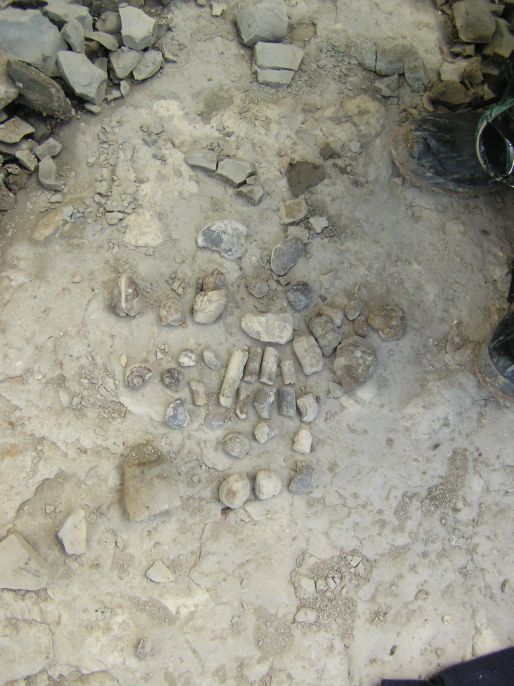
Some of Paige's finds.
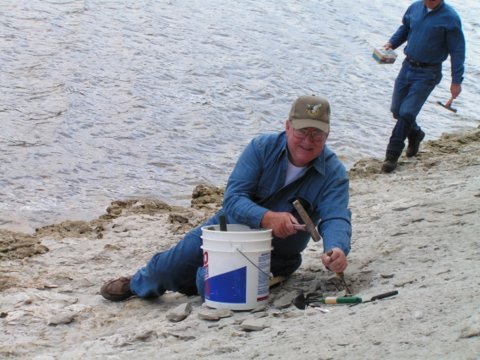
Gilbert has found another one (what, I don't know!)
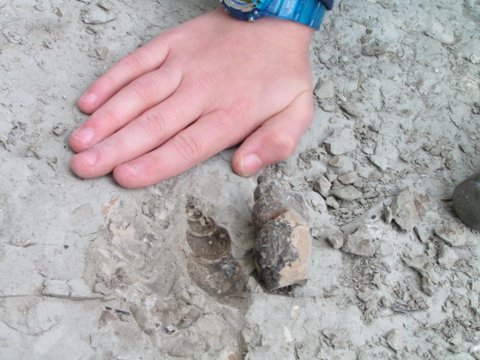
Nice gastropod and the impression it left in the chalk, found by either Lea or Paige.

Nice partial ammonite in place. It really blends in with the boulder quite well. Several people passed by without spotting it, leaving it for Vicki to find!
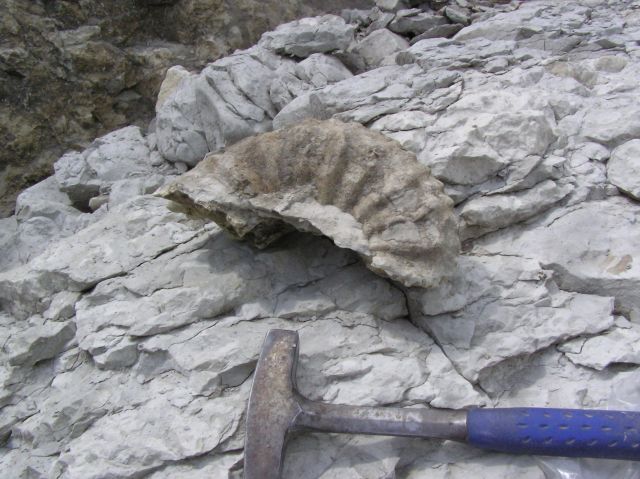
Same ammonite after excavation. This is the bottom that was protected from weathering.
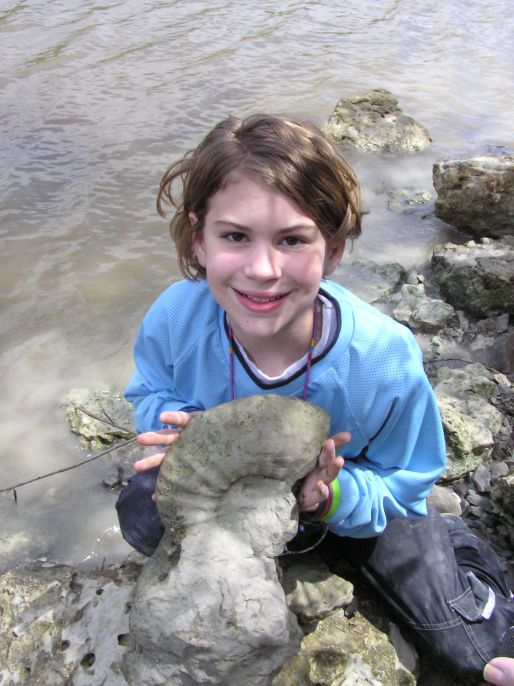
Paige holding an ammonite found by Claire.
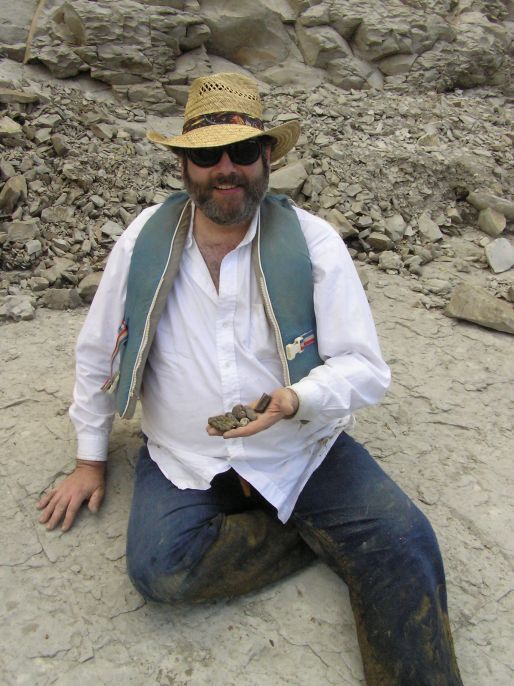
Carl showing off his favorite finds.

Captain Steve and Captain Gilbert. Thanks, guys!
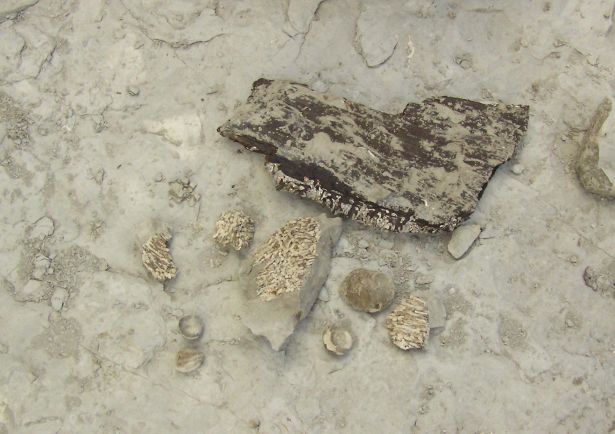
Gilbert found some fossil carbonized wood and a mass of what is either worm tubes or bryozoans.
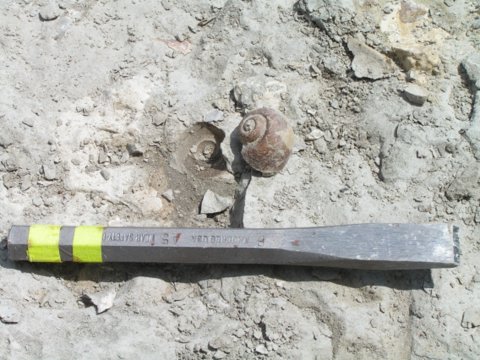
Another nice gastropod and image it left in the chalk.
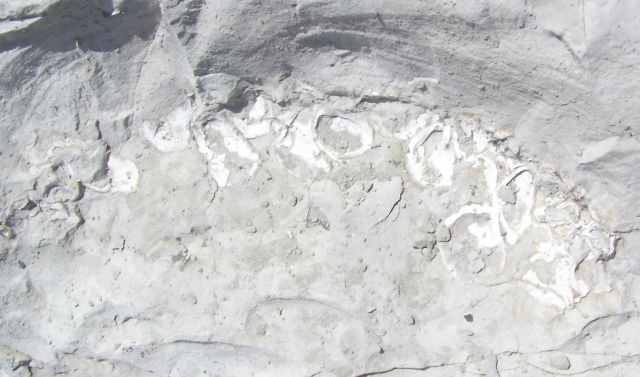
Shells embedded in the chalk.
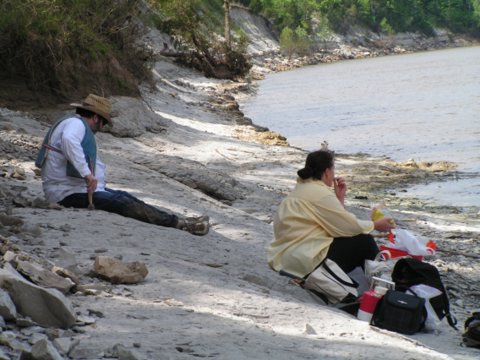
Carl & Leisa, tuckered out after a long day.
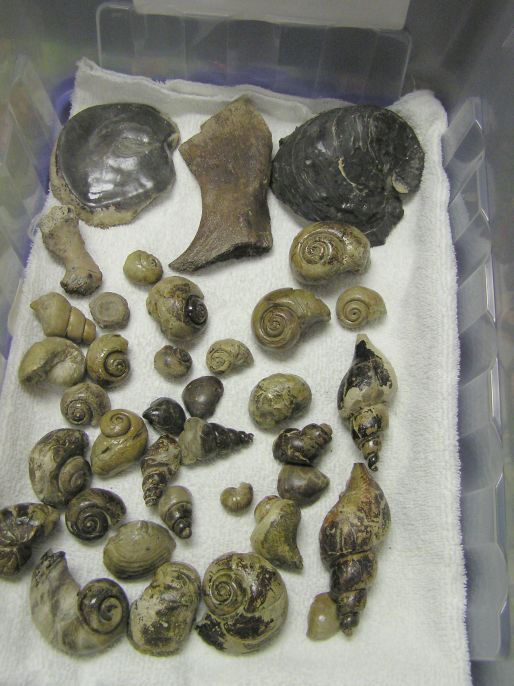
Steve's finds, all cleaned up and protective coating applied.
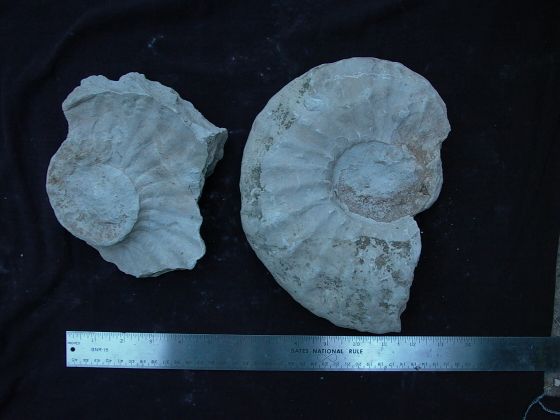
Nice Ammonite found by Claire (after cleaning)
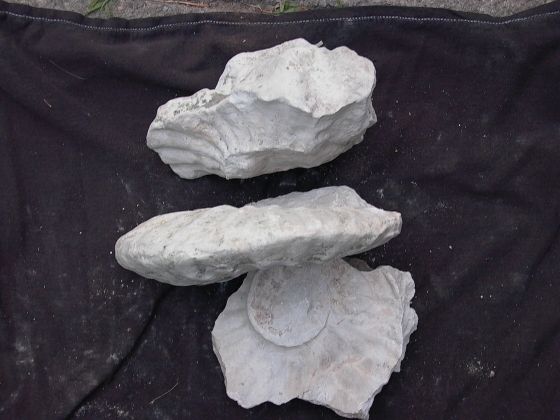
Another view of the ammonite.
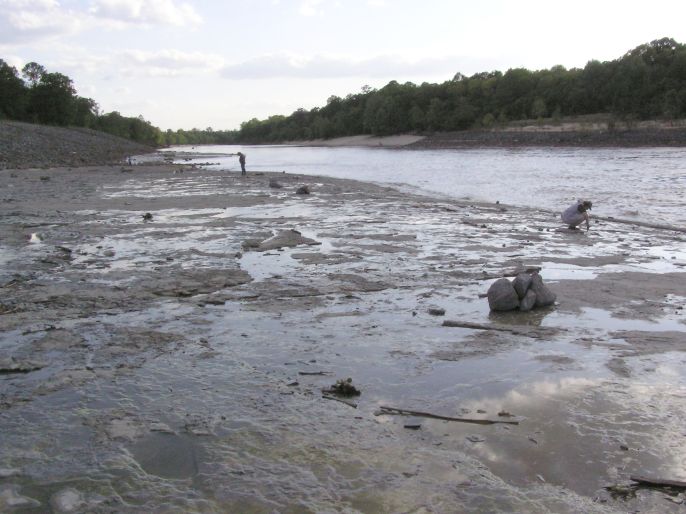
A limestone shelf filled with fossils found in the late evening. Nice to look at, but the fossils were too fragile to collect. Below is our "picture collection".
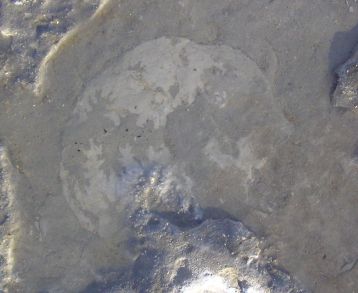
Nice ammonite.
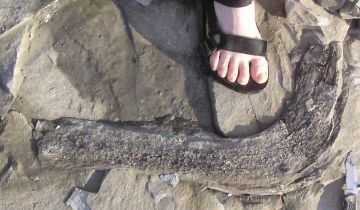
A limb of carbonized wood.
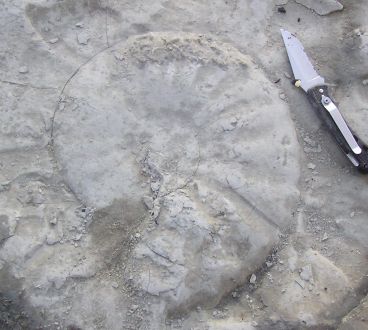
Another nice ammonite.
May 22, 2004 - Cretaceous Fossils, Sumter Co, AL
As Bobby came over to see what all the fuss was about, he saw "odd shapes" sticking out of the chalk about 15 feet before he got to where Greg was working, and after looking closely, realized it was several more vertebra. Steve came over to assist in excavating this new pile of bones. The other part of the group had gone to another nearby beach, and were basking in the sun (and I suspect they went swimming based on Nancy's drenched appearance!). They decided to ride back over after all the hard work had been done, and see what we had found. Then Jan asked if we had looked under that tree trunk beside us. Well, no. So the trunk was moved, and low and behold, there were about 5 more vertebra under it, which were also excavated. So this was truly a group find, and everyone got to work on the excavations, initial cleaning, and proper packing.
Bill, with the assistance of Leisa, did a great job on the site survey and drawings. Greg, who worked many years with the paleontologists at Red Mountain Museum, supervised the excavation and has been preparing the fossil bones for display. Thanks to all for the fine work and photos! (NOTE: any professional paleontologist who desires to study these fossils, please send your request via email.)
Afterwards, a number of members went to another river site in Sumter county to collect marcasite.
Bill Cunningham also contributed to this report.
(Photos courtesy of Nancy Kenfield, Bill Cunningham, Vicki Lais, and Greg Mestler.)
(Click images for larger view.)
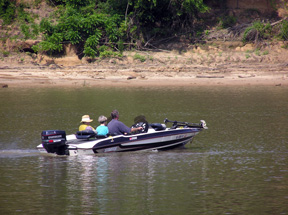
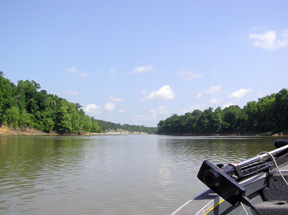
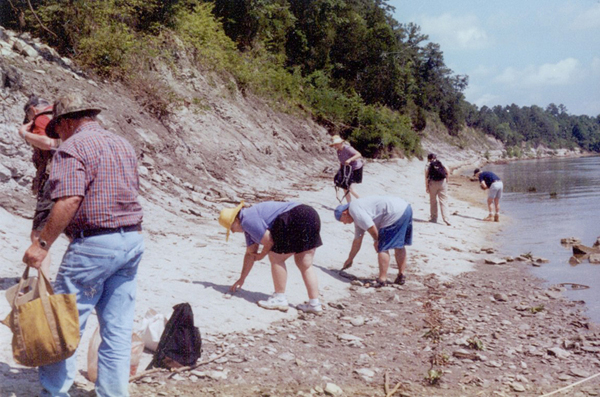
In large photo above, this is the leftmost vertebra, immediately after excavation. 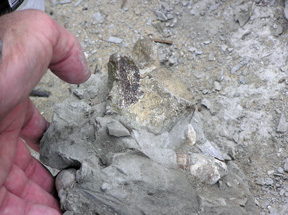 Top view of vertebra.
Top view of vertebra.
Bottom view. 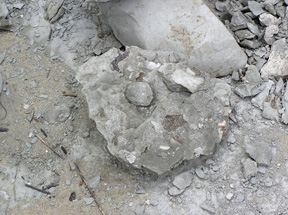
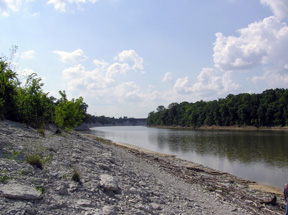
One of the many gastropods found. 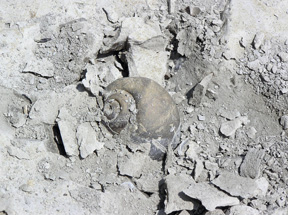
What did you find?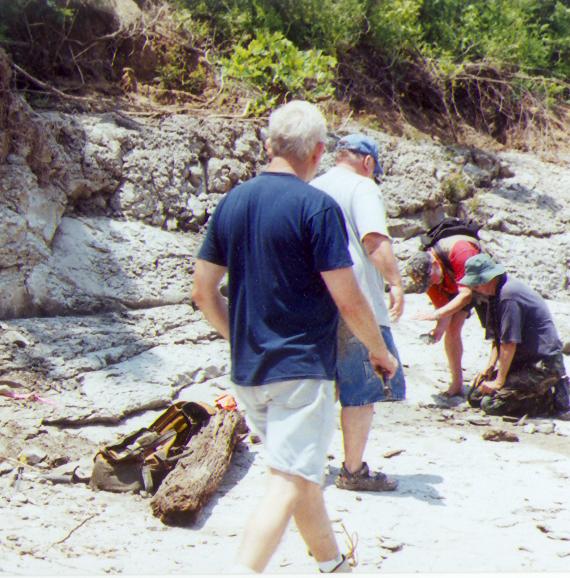
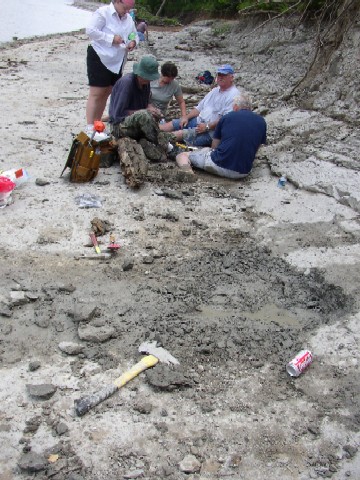
Vertebral column extends 7 meters from near Coke can to several feet beyond the excavators.
The excavation site had a small drainage problem...
Samples of typical finds - ammonite, straight cephalopod, gastropod, turritella, limpet, oyster.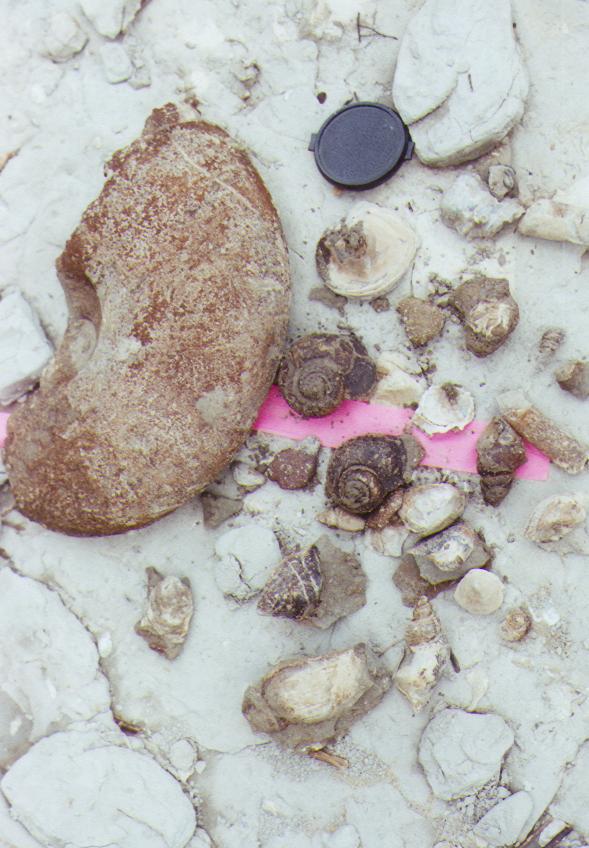
Steve with his latest treasures.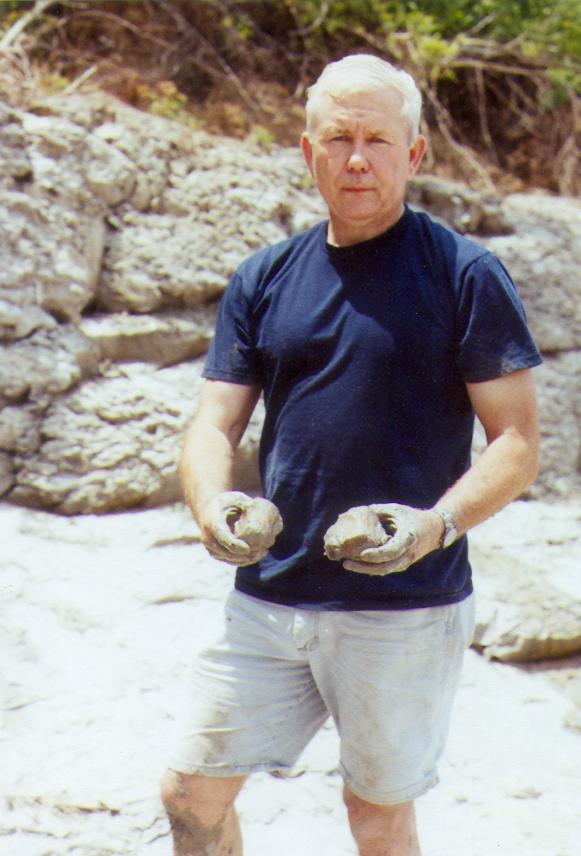
Bobby washing mud off the vertebra.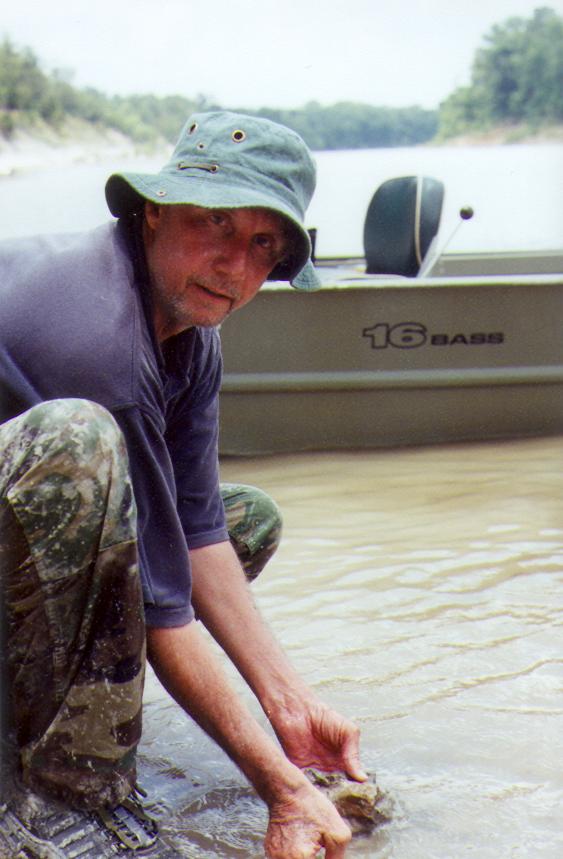
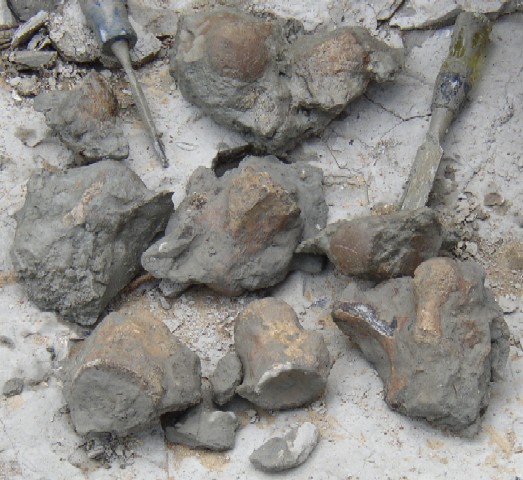
Group of eight vertebra.

Three vertebra in situ (about 15cm apart)
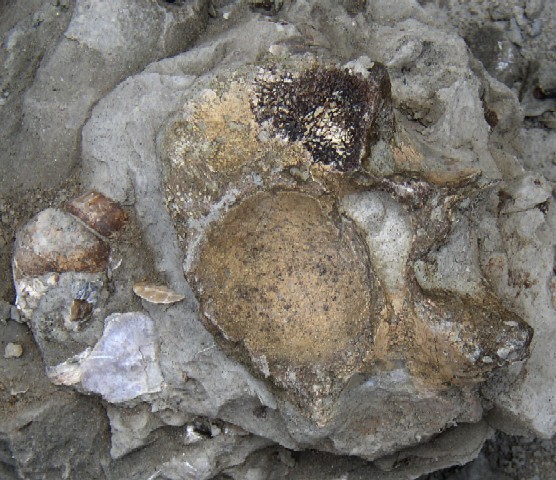
A vertebra in matrix (caudal concave discoid about 5cm)
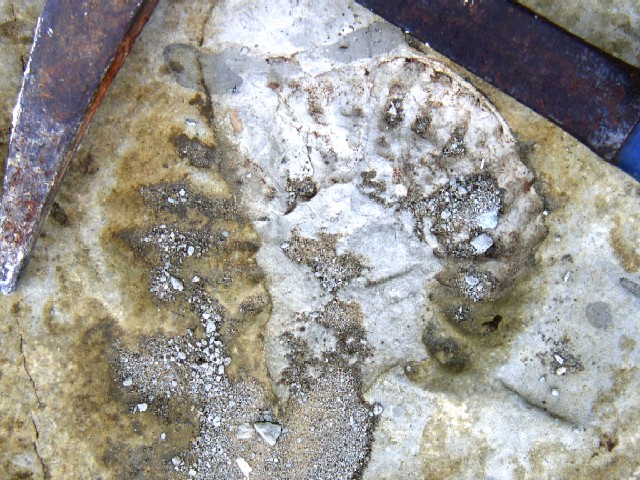
Ammonite impression (about 30cm)
Local wildlife.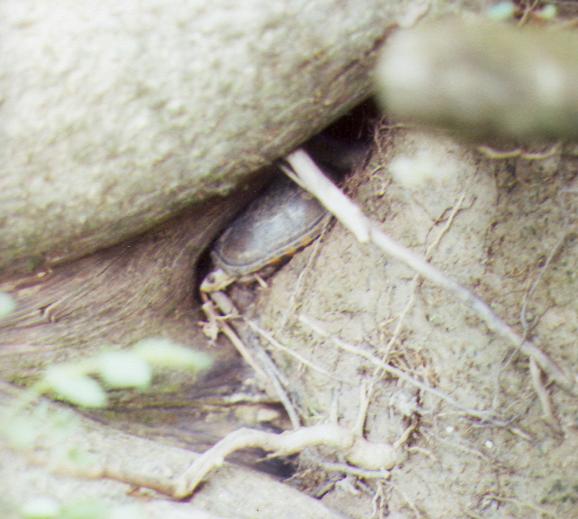
Water hyacinths are pretty, but is an invasive species that destroys our rivers and lakes, and it is prohibited to sell it in the state of Alabama. Thick infestations can make boating or swimming impossible.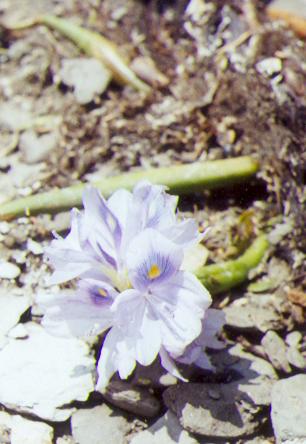
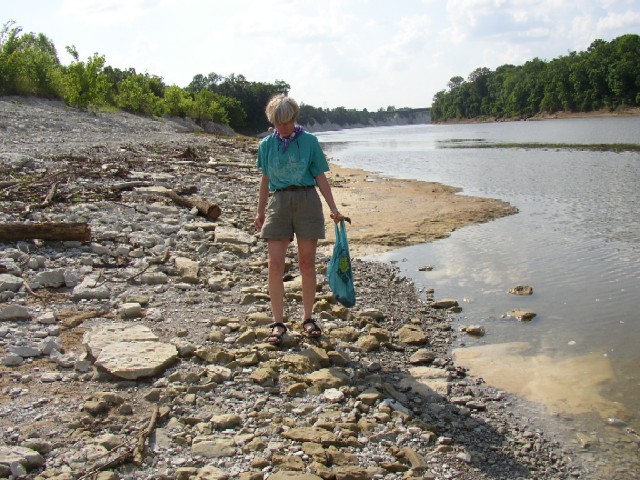
Several members traveled to another Sumter County location to collect marcasite.

White chalk cliffs in Sumter County, AL.
September 27, 2003 - Sumter Co, AL
After a quick afternoon thunderstorm, several members and guests went further south to Epes. Numerous marcasite and calcite crystals were found. But the find of the day was a plesiosaur limb bone found by Ron, that appears to have been chewed on by a shark. How exciting to have found a possible relative of Nessie, the Loch Ness monster, right here in Alabama!
(Photos courtesy Claire Smith and Vicki Lais)
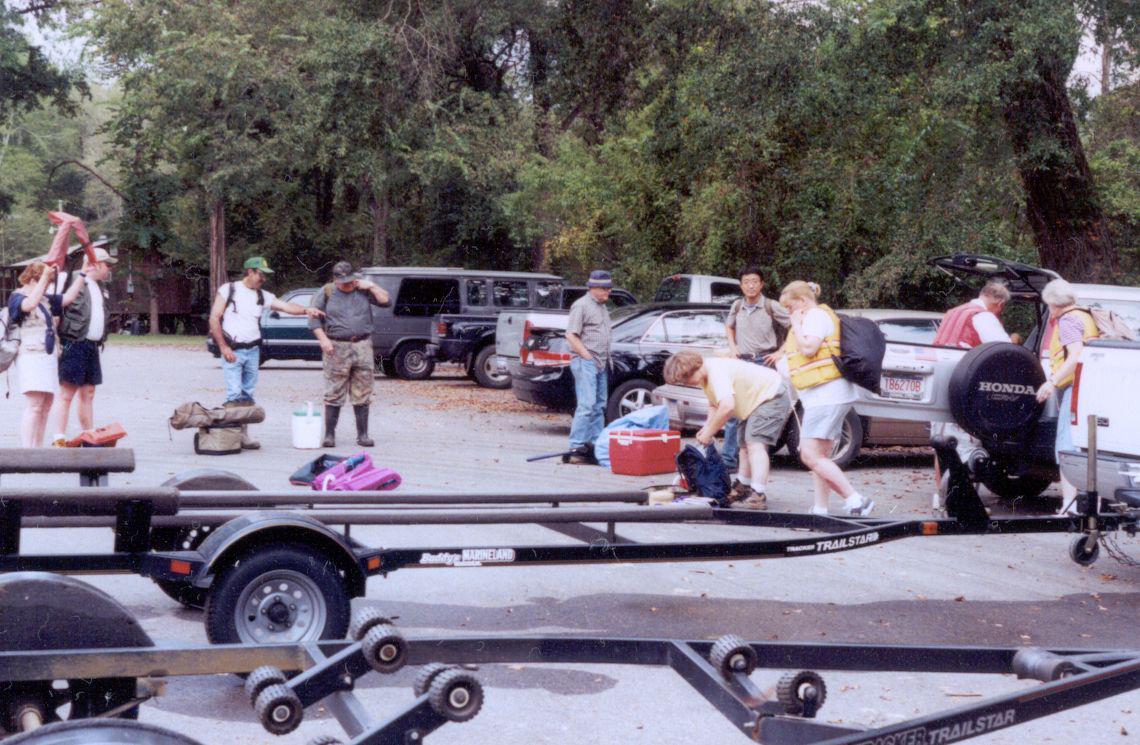
Getting ready to head down the river.

View of the bluffs from the water.
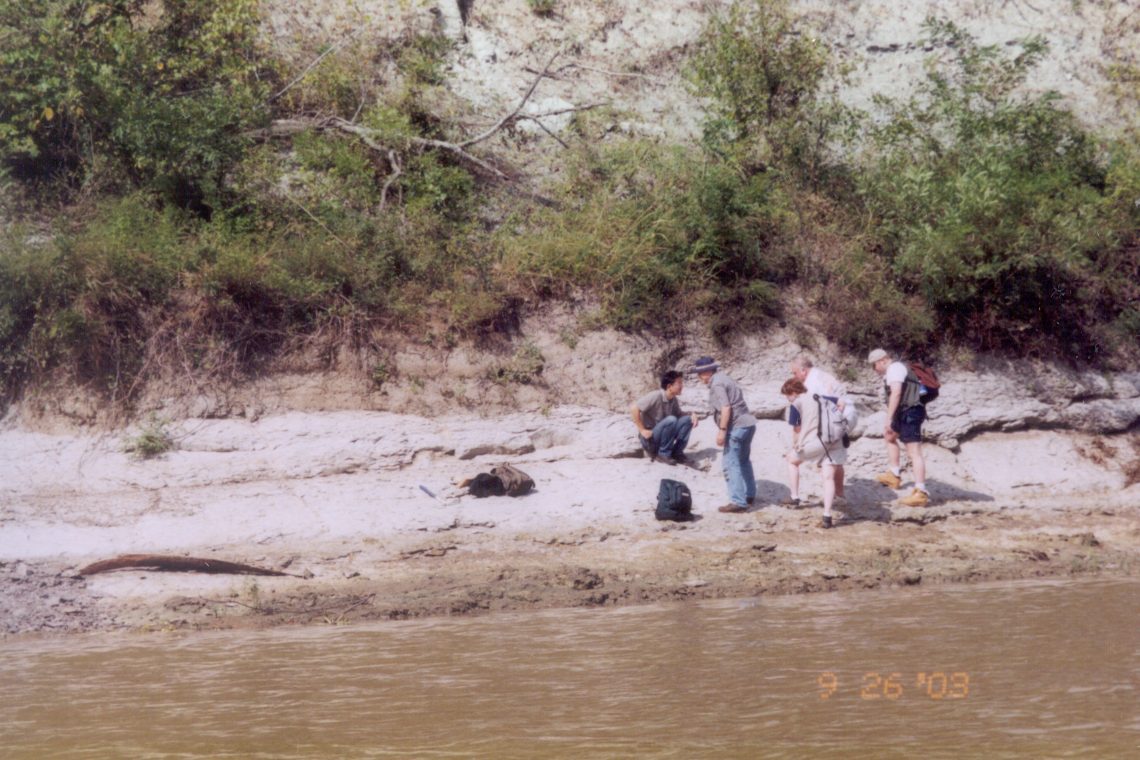
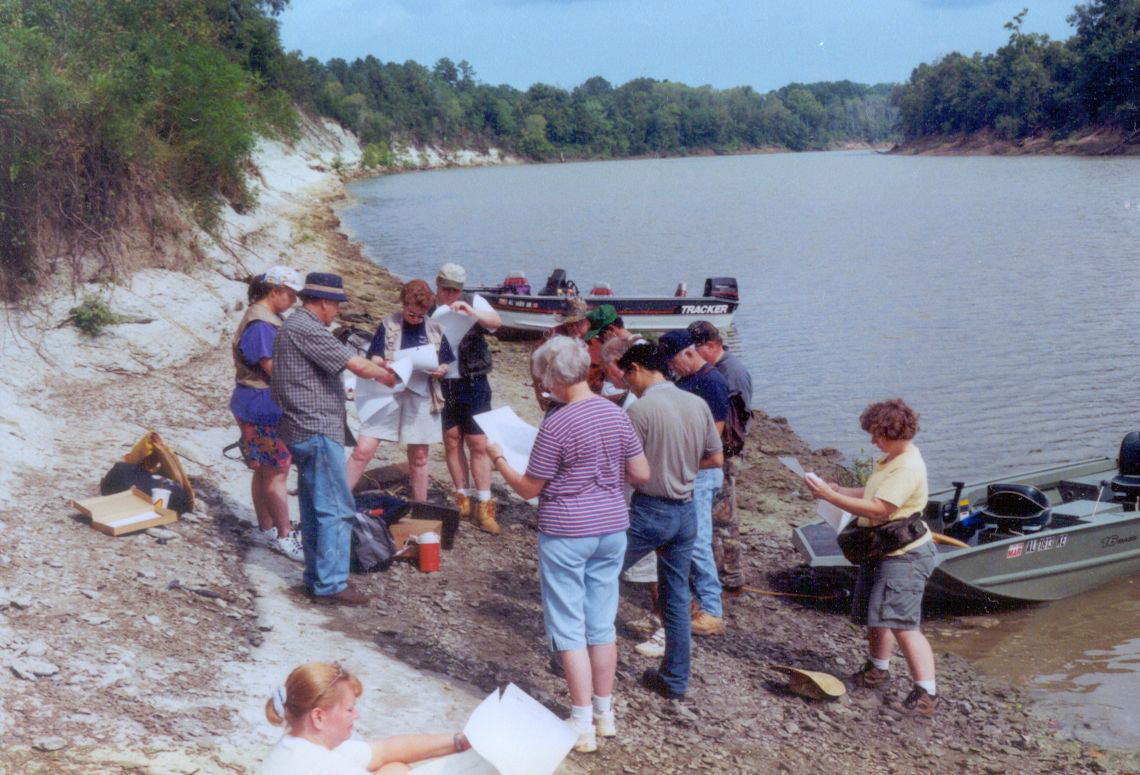
Eager students listening to Dr. Smith lecturing on this site. He has published numerous articles on the Arcola Limestone Member (Upper Member of the Mooreville Chalk), and the nannofossils found in it.
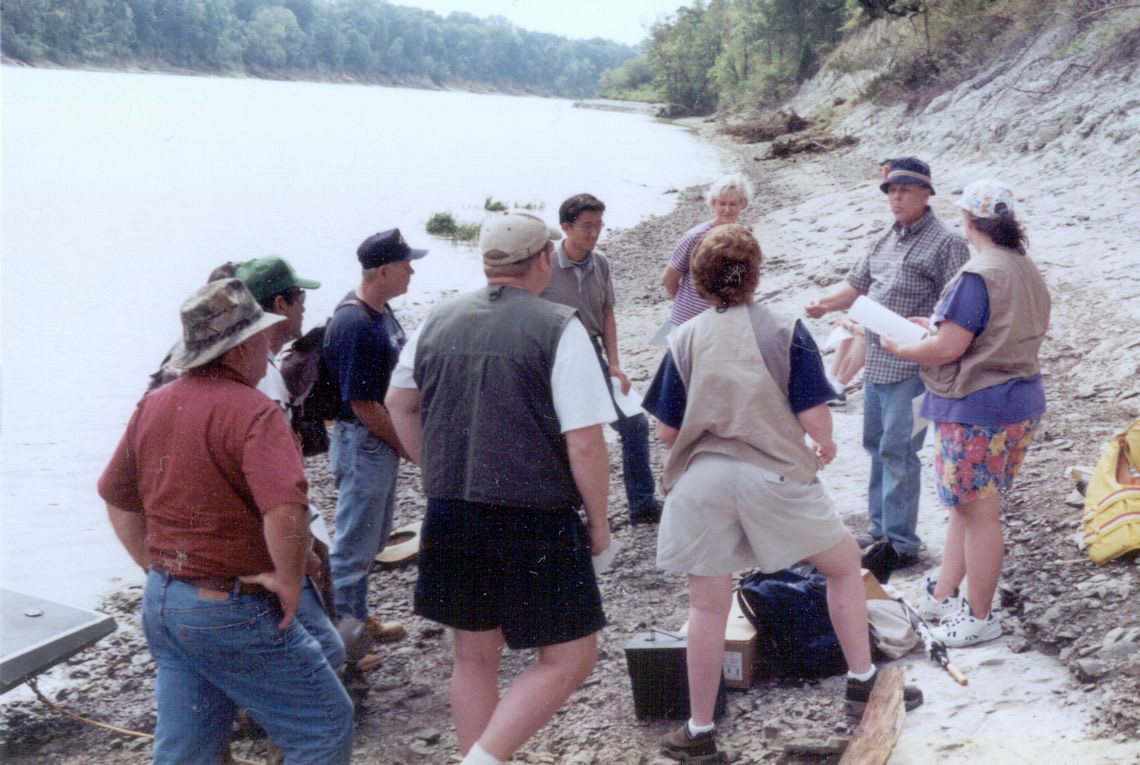
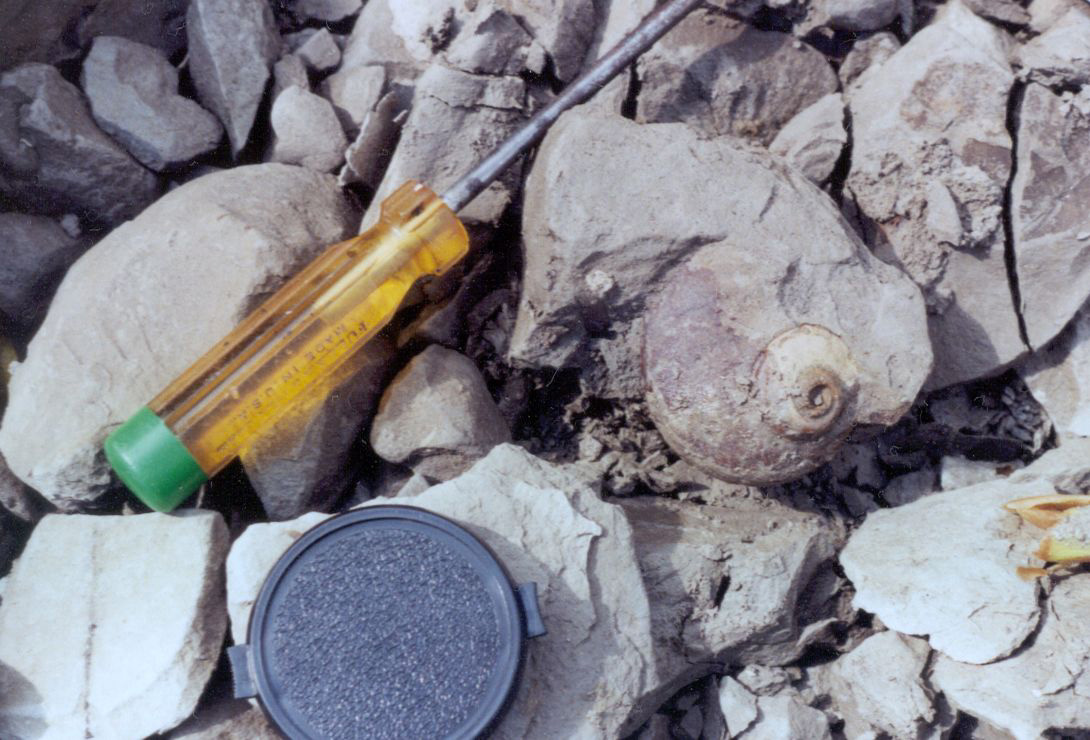
One of the very nice gastropods found at this site.
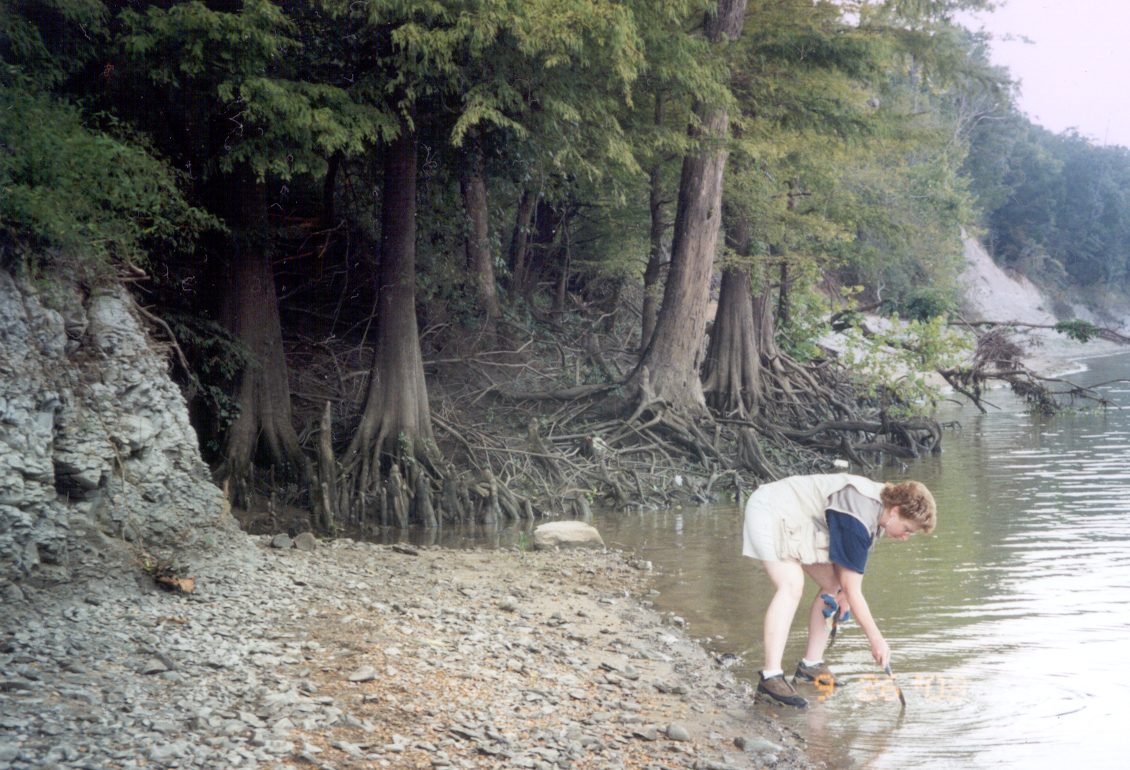
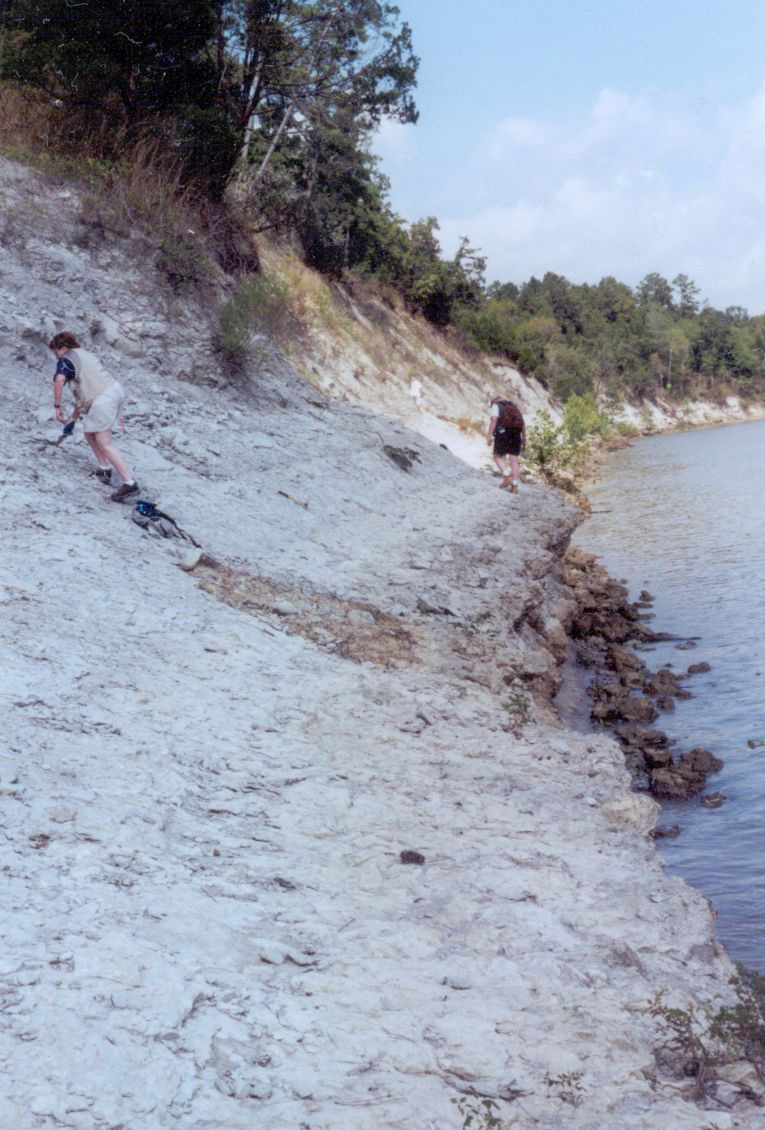
Slippery when wet...
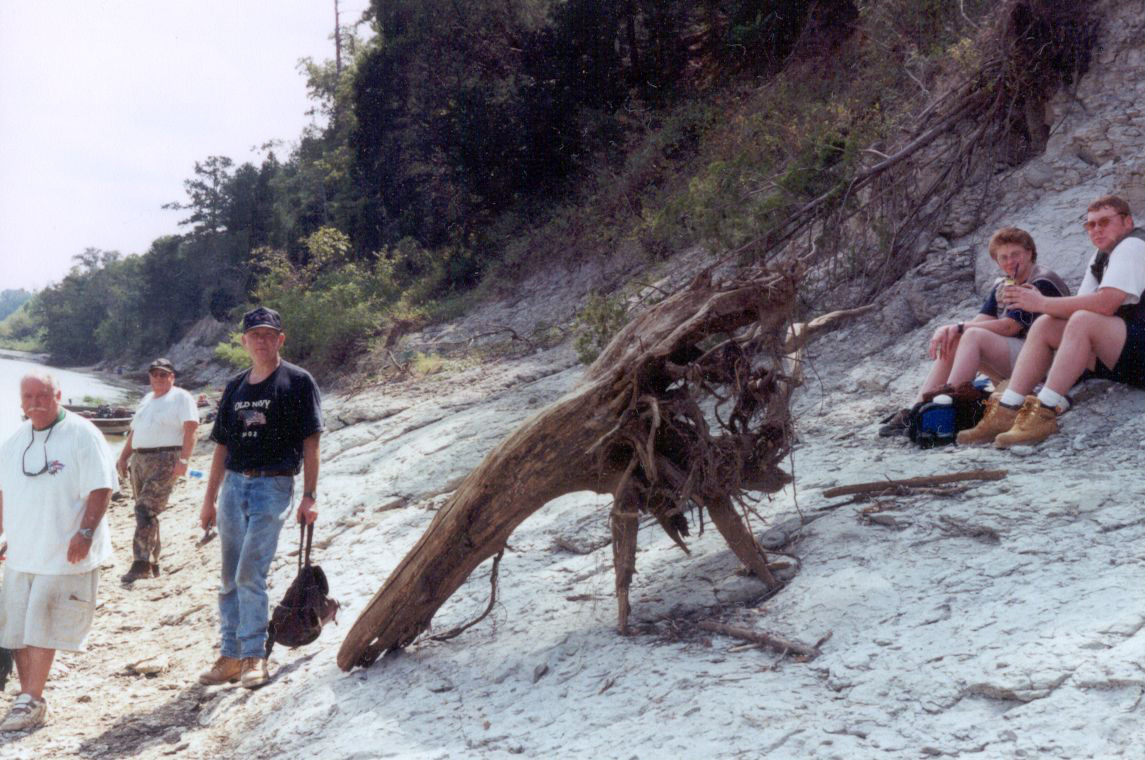
Lunchtime slowdown..
Some of you may get a little wet. . . ..
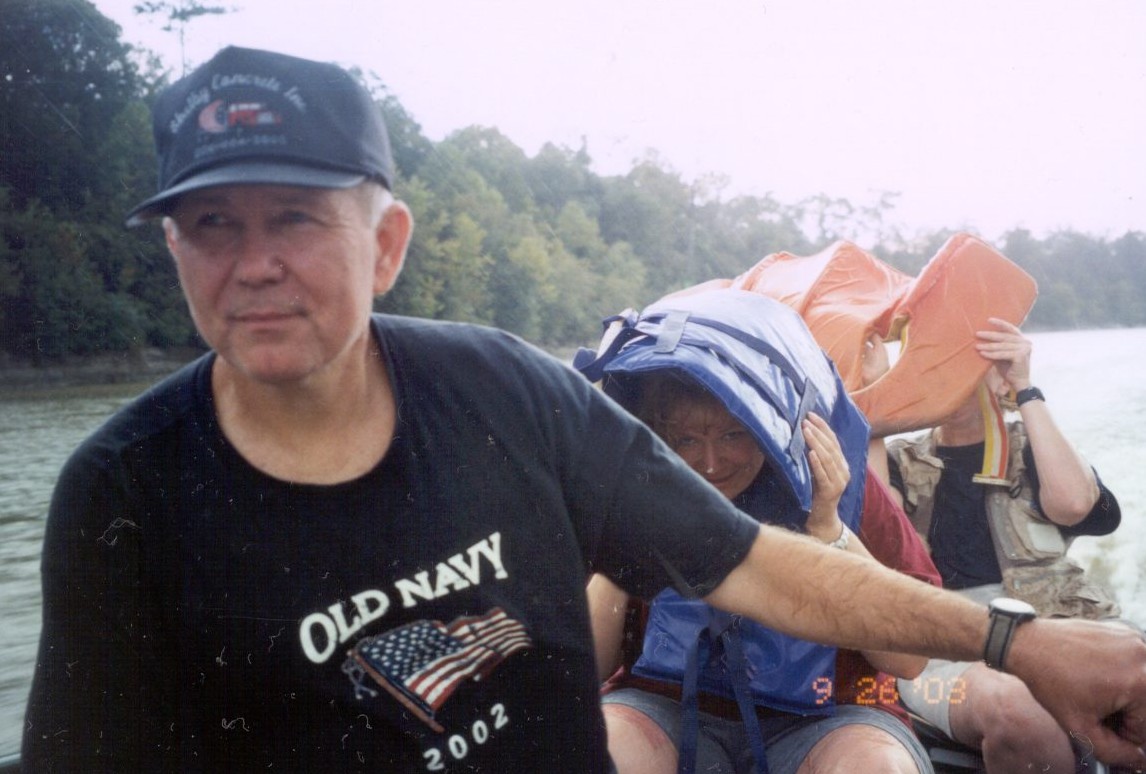

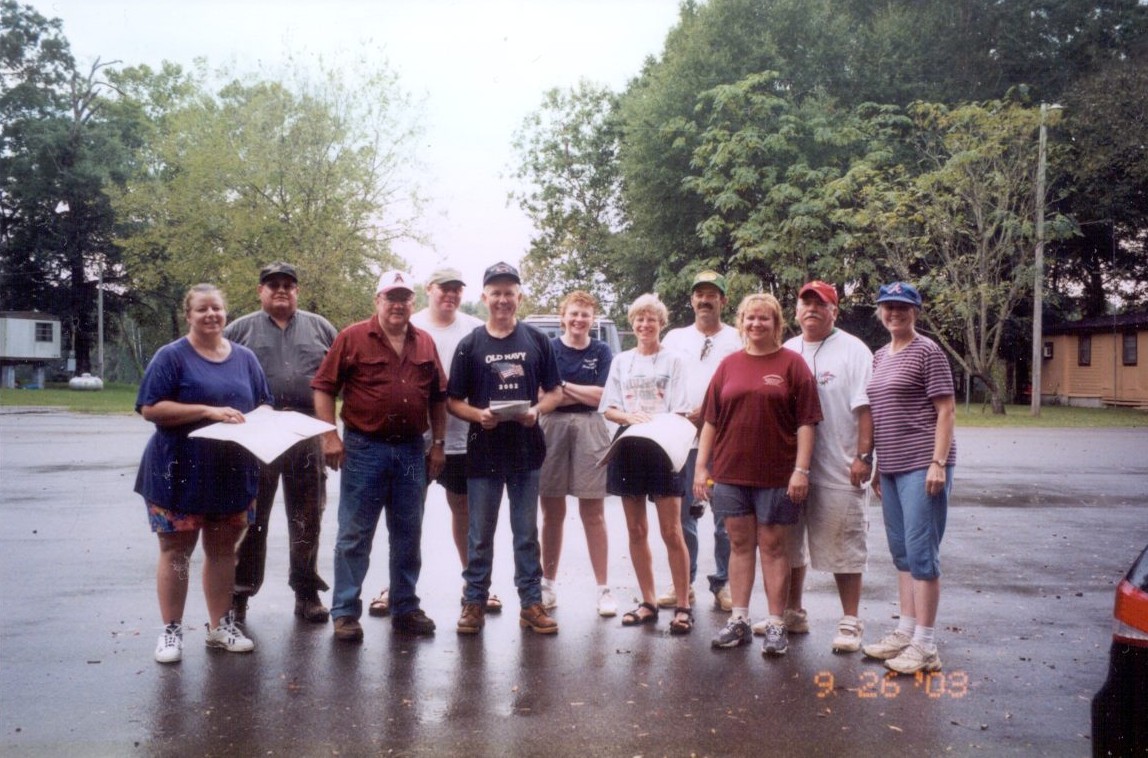
After the afternoon shower, some members and guests decided to head south to Epes.
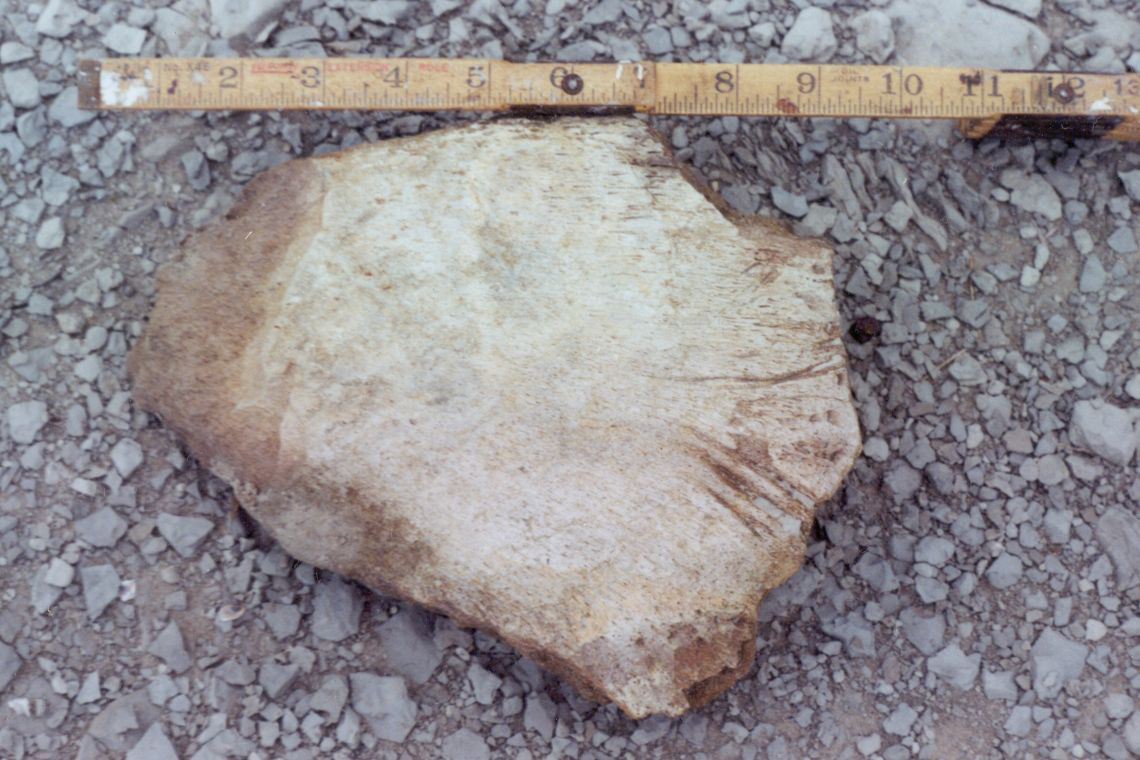
Ron found the specimen of the day! James Lamb, Curator of Paleontology at the McWane Science Center, personally examined this specimen and identified it as a plesiasaur limb bone, with some shark teeth bite marks. It is the elbow joint of the humerous.
July 1, 2000 - Cretaceous Fossils, Sumter Co, AL
This report (installed on Sept. 27) is late because of the month-long trip to South Africa that I took from mid-July to mid-August. As a result, I can only roughly describe what the BPS did this day. There were three sites in Sumter County that were visited, all well-known and previously visited by the BPS.
| There are numerous Late Cretaceous chalk exposures in Sumter Co. One of these is found in a field near Livingston, and includes numerous shells, shell fragments, and other fossils (see Figures 1 and 2). The site is visited annually by various groups, and is known for the tiny echinoids (Boletechinus mcglamerii) which can be found there. Several were found on this day, one of which is shown in Figure 3. | 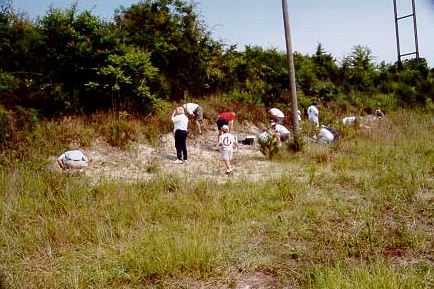 |
| Fig. 1 - BPS members and guests collecting Late Cretaceous marine fossils. |
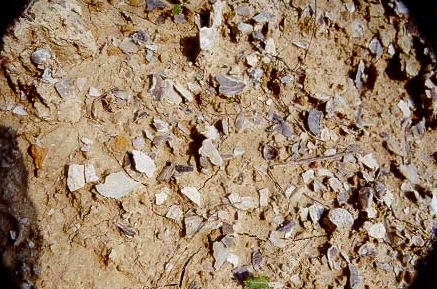 |
| Fig. 2 - Close-up view of a small part of the outcrop, showing numerous shells and shell fragments. The whole area shows a similar distribution of fossils. |
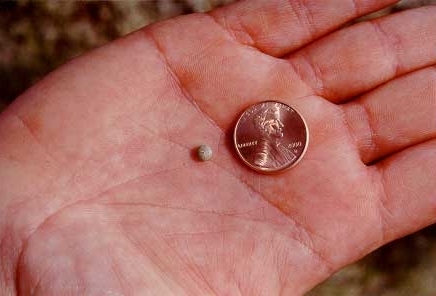 |
| Fig. 3 - One of the small echinoids this site is famous for having. The echinoids are called Boletechinus mcglamerii, and are named for one of Alabama’s state paleontologists, Winnie McGlamery, according to Dave Kopaska-Merkel. |
| One of the highlights of the visit was the apparent fossil "claw" held by Alan Collins in Figure 4. The interpretation as a "claw" is not clearcut , however. Dave Kopaska-Merkel (Geological Survey of Alabama) suspects the piece could also be the hinge of a large oyster. | 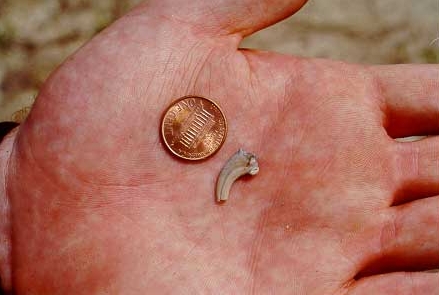 |
| Fig. 4 - Possible claw (or, alternatively, the hinge of a large oyster), held by Alan Collins. |
| Figure 5 shows a general mix of the types of fossils found at this site in abundance, including internal molds of bivalved mollusks, steinkerns, small scallops, and oyster shells. Larger oyster shells of the genus Exogyra are also found. I originally thought the internal molds were of brachiopods, but Dave Kopaska-Merkel notes that brachiopods have calcite shells while many mollusks have aragonite shells. We mostly see internal molds of these bivalve mollusks because aragonite is much more susceptible to dissolution. | 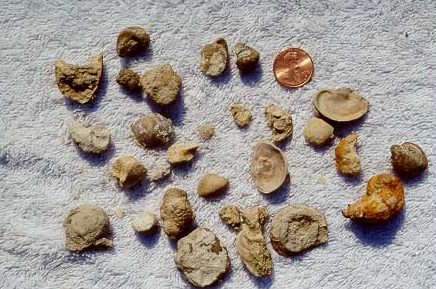 |
| Fig. 5 - A sampling of the fossils from the site, including oyster valves, internal molds of bivalve mollusks, steinkerns, and a small scallop shell. |
After spending more than an hour at this site in the intense heat, the BPS went to a site on the Tombigbee River where fossils around the K-T boundary are exposed (see Figures 6 and 7). The K-T boundary is the boundary between the end of the Cretaceous period and the beginning of the Tertiary period of Earth history. The site is well-studied and the personal favorite I have heard of Dr. Charles C. Smith of the Geological Survey of Alabama. Dr. Smith has written articles about the site and has published a stratigraphic profile showing the connection between the Late Cretaceous Prairie Bluff Chalk and the overlying Tertiary Clayton Formation. Once we arrived at the site, Dr. Andy Rindsberg (also of the GSA) gave the BPS a brief discussion of the significance of the site and what we could expect to find there. After spending a month in South Africa where fossil collecting is highly regulated, I am, in retrospect, surprised that we are allowed to collect at this site. Still, it was a great pleasure to do this and extremely educational.
|
||
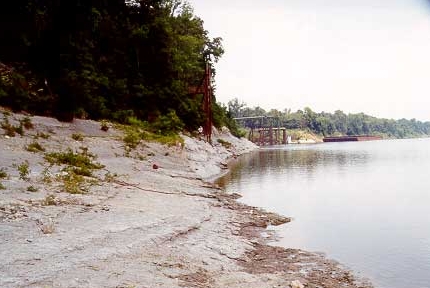 |
| Fig. 7 - View of river facing in opposite direction from Figure 6. |
On looking at the boundary, one readily notices that the fossils below are different from the ones above. Figures 8 and 9 show some of the lower fossils while Figure 10 shows the upper fossils. Oysters from below include Exogyra costata, while those from above include Ostrea pulaskensis ("pulies" for short according to Andy Rindsberg). I think the pulies are the small gray oysters in Figure 10. Figure 9 shows some gastropods, internal molds, and a fragment of a cephalopod shell that I at first thought was a crinoid stem. Also, Figures 8 and 9 show strange fossils, probably connected with large bivalve mollusks, that have a "brain matter" look. According to Dave Kopaska-Merkel, sponges bored into the aragonitic shells of the bivalves, and their borings become filled with calcitic mud. Later, the aragonite dissolved, but the filled borings remained and these preserved the general form of the shells. |
||
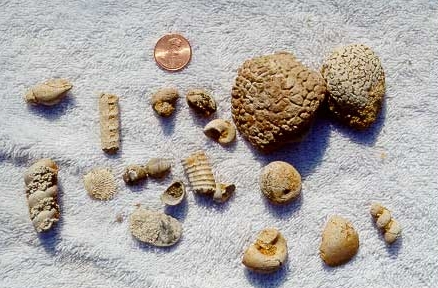 |
| Fig. 9 - Cretaceous fossils from closer to the river, including gastropods, internal molds of bivalve mollusks with holes due to boring sponges, and a fragment of a cephalopod shell. |
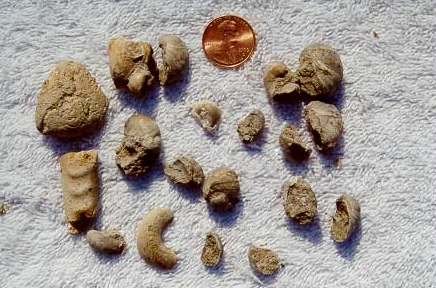 |
| Fig. 10 - Tertiary fossils from the light gray area, just above the K-T boundary in Figure 6. The small gray shells are Ostrea pulaskensis. |
| The third site the BPS had planned to visit was the oyster fields in the Belmont area. I did not attend this part of today’s trip, but I have been there before, and show in Figures 11 and 12 photographs I took two years ago. The site is absolutely remarkable in the large numbers of giant Exogyra and Pycnodonte oyster shells. A variety of shells are found at this site and are summarized in a pamphlet provided by the GSA. | 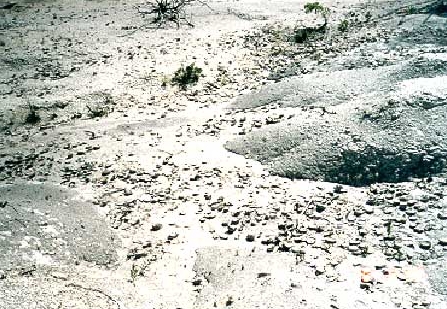 |
| Fig. 11 - A field of Late Cretaceous oyster shells, near Belmont, Alabama. |
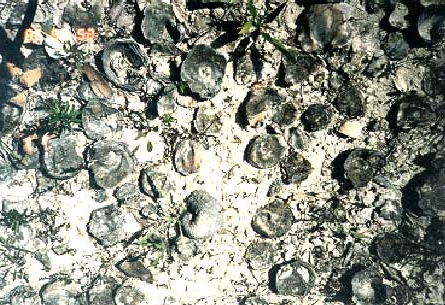 |
| Fig. 12 - A close-up of a typical area in one of the above fields, showing shells mainly of the genera Exogyra and Pycnodonte. |
In summary, this was a very pleasant and interesting field trip for the BPS. Given how much time many of us have spent at the Union Chapel Mine collecting tracks and plant fossils recently, today’s trip was a nice break from the strip mine rock piles. Thanks to Dave Kopaska-Merkel for comments and revisions to this belated report!
